Samsung Electronics Co SCHN393 Dual-Mode Cellular Phone (AMPS/CDMA) User Manual
Samsung Electronics Co Ltd Dual-Mode Cellular Phone (AMPS/CDMA) Users Manual
Users Manual

ELECTRONICS
World Wide Web
http://www.samsungmobile.com
Printed in Korea
Código No.: GH68-0xxxxA
English/Hindi. 10/2003.Rev.1.0
Please read this manual before operating your phone, and keep it
for future reference.
* Some contents in this manual may differ from your phone
depending upon the software of the phone or your service
provider.
User’s Manual
CELLULAR PHONE
SCH-N393
Kimera 2

3
Important Safety Precautions .................................................. 7
Unpacking ................................................................................... 9
Your Phone
Phone Layout ............................................................................... 10
Display ......................................................................................... 13
Backlight ...................................................................................... 15
Service Light ................................................................................. 16
Camera ........................................................................................ 16
Getting Started
Using a Battery ............................................................................. 17
Switching the Phone On or Off ....................................................... 21
Using the Soft Keys ........................................................................ 22
Your Phone’s Modes ...................................................................... 23
Call Functions
Making a Call ................................................................................ 25
Emergency Dialing ........................................................................ 26
Redialing the Last Number ............................................................ 27
Making a Call from Phonebook ..................................................... 27
Prepend Dialing ............................................................................ 28
Speed Dialing ............................................................................... 28
Four-digit Dialing .......................................................................... 30
Pause Dialing ............................................................................... 31
Voice Dialing ................................................................................ 33
Adjusting the Volume .................................................................... 34
Answering a Call ............................................................................ 34
Options During a Call ..................................................................... 36
Using Caller ID .............................................................................. 37
Viewing Missed Calls ...................................................................... 37
Quickly Switching to the Vibrate Mode ........................................... 38
Quickly Switching to the 1-Beep Mode ........................................... 38
Call Forwarding ............................................................................. 39
Call Waiting ................................................................................... 39
Three-Way Calling .......................................................................... 40
Table of Contents

4 5
Entering Text
Changing the Text Input Mode ........................................................ 42
Using the T9 (English) Mode .......................................................... 43
Using the Alphabet Mode ............................................................... 45
Using the Symbol Mode ................................................................. 47
Using the Number Mode ................................................................ 47
Using the Menus
Accessing a Menu Function by Scrolling .......................................... 48
Accessing a Menu Function by Using its Shortcut...............................49
List of Menu Functions ................................................................... 50
Phone Book
Find (Menu 1-1) ........................................................................ 53
Add Entry (Menu 1-2) ............................................................... 55
Groups (Menu 1-3) ................................................................... 59
Memory Status (Menu 1-4)......................................................... 60
Messages
Write (Menu 2-1) ....................................................................... 61
Inbox (Menu 2-2)....................................................................... 64
Outbox (Menu 2-3) .................................................................... 65
Saved (Menu 2-4) ...................................................................... 66
Templates (Menu 2-5)................................................................. 67
Erase Messages (Menu 2-6)........................................................ 67
Settings (Menu 2-7).................................................................... 68
Voice Mail (Menu 2-8)................................................................ 70
Call History
Missed (Menu 3-1) ..................................................................... 71
Received (Menu 3-2) ................................................................. 72
Dialled (Menu 3-3) .................................................................... 73
Erase History (Menu 3-4)............................................................ 73
Call Duration (Menu 3-5)............................................................ 74
Sound
Ring Tones (Menu 4-1) .............................................................. 75
Ringer Volume (Menu 4-2) ........................................................ 76
Alerts (Menu 4-3) ..................................................................... 77
Key Tone (Menu 4-4) ................................................................ 78
Power On/Off Melody (Menu 4-5) .............................................. 78
Display
Language (Menu 5-1) ............................................................... 79
Service Area (Menu 5-2) ........................................................... 79
Menu Theme (Menu 5-3) .......................................................... 80
Wallpaper (Menu 5-4) ............................................................... 80
Banner (Menu 5-5) .................................................................... 81
Backlight (Menu 5-6) ................................................................ 82
Set Dual Clock (Menu 5-7) ........................................................ 83
Service LED (Menu 5-8) ............................................................. 83
Contrast (Menu 5-9) .................................................................. 83
Organiser
Scheduler (Menu 6-1) ................................................................ 92
Task List (Menu 6-2) ................................................................. 95
Memo Pad (Menu 6-3) .............................................................. 97
Alarm (Menu 6-4) ..................................................................... 98
Calculator (Menu 6-5) ............................................................... 99
World Time (Menu 6-6) ........................................................... 100
Countdown (Menu 6-7) ............................................................ 100
Settings
Call (Menu 7-1) ....................................................................... 102
Phone/System (Menu 7-2) ...................................................... 105
Security (Menu 7-3) ............................................................... 106

7
YYoouurr PPhhoonnee
6
R World
R-Menu (Menu 8-1).................................................................. 110
Multimedia (Menu 8-2).............................................................. 111
Games (Menu 8-3) .................................................................... 112
Reset R-Menu (Menu 8-4).......................................................... 113
Camera
Take Photo (Menu 9-1) ........................................................... 114
Photo Album (Menu 9-2) ......................................................... 119
Photo Wallet (Menu 9-3) ......................................................... 121
Settings (Menu 9-4) ................................................................ 122
Health and Safety Information
Exposure to Radio Frequency (RF) Signals .................................... 123
For Body Operation ..................................................................... 125
Precautions When Using Batteries ................................................. 126
Road Safety ................................................................................. 128
Operating Environment................................................................. 130
Electronic Devices ........................................................................ 131
Potentially Explosive Atmosphere.................................................. 133
Emergency Calls ........................................................................... 134
Other Important Safety Information.............................................. 135
Care and Maintenance.................................................................. 136
Acknowledging Special Precautions and the FCC and
Industry Canada Notice ................................................................ 138
Glossary ...................................................................... 140
Index............................................................................ 143
Quick Reference Card.................................................... 147
Important Safety
Precautions
Read these guidelines before using your wireless
phone. Failure to comply with them may be dangerous
or illegal.
Road Safety at All Times
Do not use a hand-held phone while driving; park the
vehicle first.
Switching Off When Refueling
Do not use the phone at a refueling point (service
station) or near fuels or chemicals.
Switching Off in Aircraft
Wireless phones can cause interference. Using them in
aircraft is both illegal and dangerous.
Switching Off in Hospitals
Switch off your phone near medical equipment.
Follow any regulations or rules in force.
Interference
All wireless phones may be subject to interference,
which could affect their performance.
Special Regulations
Meet any special regulations in force in any area and
always switch off your phone whenever it is forbidden
to use it, or when it may cause interference or danger
(in a hospital for example).

8 9
Travel Adapter
Handset Standard Battery
Hand Strap
Unpacking
Your package contains the following items:
In addition, you can obtain the following accessories for
your phone from your local Samsung dealer:
Notes:
• This phone can be used as a wireless modem, by
using the Data Cable for connecting the phone to the
USB port of a PC or Laptop. You need to purchase the
Data Cable/Driver to use this feature. Contact Reliance
for further information.
User’s Manual Headset
Battery Charger
• Headset
• Travel adapter
• Standard battery
• Cigarette light adapter
• Data Cable(USB support)
• Car Cradle
• Cigar hands-free car kit
IImmppoorrttaanntt SSaaffeettyy PPrreeccaauuttiioonnss
Sensible Use
Use only in the normal position (held to the ear). Avoid
unnecessary contact with the antenna when the phone
is switched on.
Emergency Call
Ensure the phone is switched on and in service.
Key in the emergency number for your present location,
then press the key. If certain features are in use,
deactivate those features before you can make an
emergency call. Give all the necessary information as
accurately as possible. Do not cut off the call until given
permission to do so.
Water Resistance
Your phone is not water-resistance. Keep it dry.
Accessories and Batteries
Use only Samsung-approved accessories and batteries.
Qualified Service
Only qualified service personnel may install or repair
your phone.
For more detailed safety information, see “Health and
Safety Information” on page 123.

11
YYoouurr PPhhoonnee
10
Perform the functions indicated by the
text above them, on the bottom line of
the display.
In Menu Mode, scrolls through the menu
options and Phonebook memory.
In Standby Mode, accesses the following
menus:
• : Messages
• : Voice Memo
• : Scheduler (All)
• : Ring Tones
Key Functions
Headset
jack
Microphone
Earpiece
Display
Your Phone
Phone Layout
The following illustrations shows the main elements of
your phone:
Camera
module
Volume keys
During a call, adjust
the voice volume.
In Standby Mode
with the folder
open, adjust the key
tone volume.
In Menu Mode,
scroll through the
menu options.
(soft keys)
Adapter outlet
Makes or answers a call.
In Standby Mode, retrieves the last
numbers you dialed, received or missed.
Redials the number of the last call when
pressed twice.
Ends a call. Also switches the phone on
and off when held down.
In Menu Mode, cancels your input and
returns to Standby Mode.
Keys

13
YYoouurr PPhhoonnee
12
YYoouurr PPhhoonnee
Display
Layout
The display has three areas; an upper line of various
icons, the lower text and graphic area and the last line
containing the soft key indications.
Icons
Text and
graphic area
Soft key
indications
Enters numbers, letters and some special
characters.
In Standby Mode, initiates the voice dialing
feature when held down.
While entering text, allows you to change
the case.
Also, use this key for the special star
calling feature.
In Standby Mode, enters or exits the
vibrate mode when held down.
Also, use this key when you make a call
to an automated system, especially when
using teleservices.
Key Functions
(continued)
~
Deletes characters from the display.
In Menu Mode, returns to the previous
menu level.
Menu Find
In Standby Mode, enters or exits the
1-Beep mode when held down.
Keys (continued)
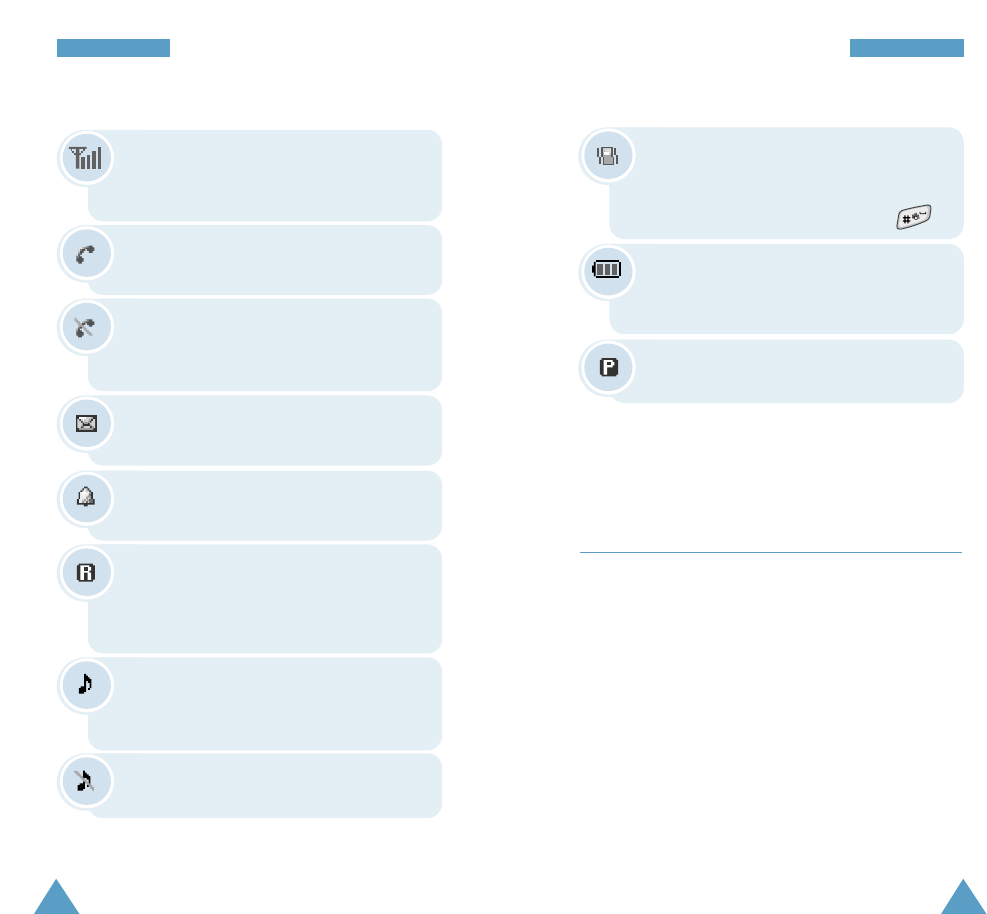
15
YYoouurr PPhhoonnee
14
YYoouurr PPhhoonnee
Backlight
The display and the keypad are illuminated by a
backlight. When you press any key or open the folder,
the backlight illuminates. It turns off if no key is
pressed within a given period of time, depending on
the Backlight option set in the Display menu.
To specify the length of time for which the backlight is
active, set the Backlight menu option (Menu 5-6);
see page 82 for further details.
Roaming: Appears when you are out of
your home area and have logged onto a
different network, when traveling in other
countries, for example.
Ringer On: Appears when you set the
ringer volume for calls to one from Level 1
to Level 8, 1-Beep.
Ringer Off: Appears when the ringer
volume is turned off.
Battery Status: Shows the level of your
battery. The more bars you see, the more
power you have left.
Alarm: Appears when you set an alarm to
ring at a specified time.
Vibration: Appears when you set the ringer
volume for calls to Vibrate or High+Vib. It
also appears in a different color when the
phone is set to Vibrate mode using .
Signal Strength : Shows the received
signal strength. The greater the number of
bars, the better the signal.
Icons
Service: Appears when a call is in
progress.
No Service: Appears when you are
outside a service area. When it appears,
you cannot make or receive calls.
New Message: Appears when a new
message is received.
Voice Privacy: Appears when the Voice
Privacy feature is activated.

1716
Getting Started
Using a Battery
Your Samsung phone comes packaged with a partially
charged, rechargeable Lithium Ion (Li-ion) battery.
Installing the battery
1. Place the battery back on the phone so that its tabs
match the grooves on the phone.
2. Slide the battery towards the top of the phone until it
snaps into place.
Make sure that the battery is correctly installed
before switching on the phone.
Note: In Standby Mode or Talk Mode, the display
automatically turns off after some time,
depending on your setting in the Backlight
menu option to conserve your battery power.
Press any key to turn the display on.
Camera
The camera module on the top left one your phone
allows you to take a picture while on the move.
For further details about the Camera feature, see page
114.
YYoouurr PPhhoonnee
Camera module

19
GGeettttiinngg SSttaarrtteedd
18
GGeettttiinngg SSttaarrtteedd
Removing the battery
1. If necessary, switch off the phone by holding down
the key until the power-off image displays.
2. Press the catch above the battery and slide the
battery away.
Charging the Battery
The travel adapter is provided with your phone to allow
you to charge your phone’s battery from a standard AC
wall outlet. Use only approved batteries and chargers.
Note: You need to fully charge the battery before
using your phone for the first time.
You can use your phone while the battery is charging,
but this increases time it will take to charge the battery.
An “empty” standard battery can be fully charged in
approximately 4 hours.
To charge the battery:
1. With the battery in position on the phone, plug the
connector from the travel adapter into the jack at the
bottome of the phone.
2. Plug the adapter into a standard wall outlet.
The battery begins charging immediately, and the
service light turns on and blinks while the battery is
charging.
3. When charging is finished and the service light stops
blinking, unplug the adapter from the power outlet
and from the phone.

21
GGeettttiinngg SSttaarrtteedd
20
GGeettttiinngg SSttaarrtteedd
Switching the Phone On or Off
1. Press and hold the key until the power-on
image displays to switch the phone on.
The service light on the phone flashes and an alert
sounds. When the system locates services, the
Banner greeting message displays along with the
date and time. You can now place and receive calls.
If the phone is out of service, the No Service icon
( ) appears on the display. In this case, you cannot
make and receive calls. You can try again later when
service is available.
Note: You can change the display language. To
change the language, use the Language menu
option (Menu 5-1). For further details, see page
79.
2. When you wish to switch the phone off, hold down
the key more than two seconds.
WARNING!
Do not switch the phone on when mobile phone use is
prohibited or when it may cause interference or
danger.
Note: As with any other radio-transmitting device, do
not touch the antenna unnecessarily when the
phone is switched on. Contact with the antenna
affects the call quality and may cause the
phone to operate at a higher power level than
otherwise needed.
Low Battery Indicator
You can easily tell if your battery needs to be recharged
by checking the Battery Status icon ( ) at the upper-
right corner of your phone’s display. The presence of all
three bars indicates a full charge, two bars indicates a
smaller charge, and one bar indicates an even smaller
charge.
When the battery charge level gets low, the battery
sensor blinks an empty Battery Status icon ( ) and
sounds a warning tone. If the battery level gets too low,
the phone automatically turns off. When this happens,
you lose whatever you are doing and your phone call
cuts off. Watch the Battery Status icon and make sure
that your battery is adequately charged.
Battery Talk Time and Standby time
Battery times can vary depending on operating
conditions, usage, signal strength and backlight setting.
Talk time usage will decrease standby time.

23
GGeettttiinngg SSttaarrtteedd
22
GGeettttiinngg SSttaarrtteedd
Your Phone’s Modes
Standby Mode
Standby is the most basic state of your phone. The
phone goes into Standby Mode after you turn it on or
whenever you briefly press the key. When your
phone is in Standby Mode, you will typically see the
Banner greeting message and the current date and time.
If you enter a phone number, you can press the key
to dial it or press the Save soft key to save it in the
internal Phonebook.
Press the key at any time to return to Standby
Mode. Be careful; if you are on a call when you press
the key, the call disconnects and the phone
returns to Standby Mode.
Talk Mode
You can place and answer calls only when your phone is
turned on. During a call, the phone is in the talk mode.
While you are in the talk mode, pressing the Menu soft
key gives you a list of options. See page 36 for details.
Using the Soft Keys
Your phone offers a set of functions that allow you to
customize your phone. These functions are arranged in
menus and sub-menus, accessed using the two soft keys
marked and . Each menu and sub-menu allows
you to view and alter the settings of a particular
function.
The roles of the soft keys vary according to the current
context; the label on the bottom line of the display just
above each key indicates its current role.
Example:
Press the left soft key
to access Menu Mode. Press the right soft key
to find a number in
your Phonebook
Menu Find

25
GGeettttiinngg SSttaarrtteedd
24
GGeettttiinngg SSttaarrtteeddCall Functions
Making a Call
In Standby Mode, enter the area code and phone
number and press the key.
Note: If the Auto Redial option (Menu 8-1-2) have been
enabled, the phone automatically retries to make
the call when the line is busy or the remote
person does not answer. See page 103.
While entering a number, press the press the Save soft
key to save the number in Phonbook, or press Options
soft key to use the following menu options:
Call: places a call to the number.
Save: allows you to save the number in Phonebook.
Find: allows you to find a number from Phonebook.
Hard Pause: enters a hard pause.
Notes:
• When you enter a number corresponding to a
Phonebook location, the Speed Dial option is
available. For details about speed dialing, see page 28.
• When you enter four digits, the 4-digit Dial option is
available. For details about four-digit dialing, see page
30.
Power Save Mode
Your phone comes with a Power Save feature that will
automatically be activated if your phone is unable to
find a signal after 15 minutes of searching. While this
feature is active, the phone’s battery charge is
conserved. The phone will automatically recheck for a
signal periodically. To manually force the phone to
recheck for a signal, press any key.
Lock Mode
When you lock your phone using the Lock Mode menu
option (Menu 8-3-1) in the Settings menu, you cannot
use the phone. In the lock mode, you can receive
messages and calls, but you cannot place an outgoing
call until you unlock the phone. To unlock the phone, you
need to enter the lock code.
The lock code is preset to “0000” at the factory.
For details about locking and unlocking your phone, see
page 106.

27
CCaallll FFuunnccttiioonnss
26
CCaallll FFuunnccttiioonnss
Redialing the Last Number
To redial the last call you made or received, press the
key twice quickly.
Your phone stores the 10 numbers each of the last
missed, received and dialed calls. To recall any of these
numbers:
1. In Standby Mode, press the key. The list of the
outgoing calls displays.
2. Press the or key to scroll to the call type you
want.
Note: When a list is empty, the next available list
displays.
3. Press the or key until you find the required
name or number.
4. Press the key to dial the number displayed.
Making a Call from Phonebook
You can store the phone numbers called regularly in the
memory, which is called Phonebook. You then simply
recall the number to dial.
For further information about the Phonebook feature,
see page 53.
Correcting the Number
To clear the Press
last digit displayed CLR key.
whole display CLR key for more than
one second.
Ending a Call
When you want to finish your call, briefly press the
key or close the folder.
If you end the call by pressing the key, the call
time, or the length of the call, displays briefly and the
phone returns to Standby Mode.
Emergency Dialing
You can place emergency calls from your emergency
number list even if your phone is locked or all of the
outgoing calls are restricted.
For more information about emergency numbers, see
page 107.

29
CCaallll FFuunnccttiioonnss
28
CCaallll FFuunnccttiioonnss
One-Touch Dial
Memory locations 001 through 009 are special one-
touch locations. You can dial the phone numbers stored
in the Phonebook memory from 001 through 009 simply
by pressing one key.
Press and hold the third digit of the memory location
containing the number to be dialed.
For example: Location no. 009
Press the 9 key and hold.
The number (and name) stored is displayed, and then
dialed.
Two-Touch Dial
Memory locations 010 through 099 are special two-
touch locations.
Press the second digit briefly, and then hold down the
third digit of the memory location.
For example: Location no. 023
Press the 2 key briefly and hold down the 3
key.
The number (and name) stored is displayed, and then
dialed.
Prepend Dialing
The prepend option lets you add digits, such as area
codes and network feature activation codes, to a phone
number that is in your Phonebook.
To prepend a phone number stored in your phone:
1. Press the Find soft key to access the Phonebook
entries.
2. Press the or key to scroll to the required
number and press the Select soft key.
3. Press the Options soft key to access the options.
4. Press the 2key to select the Prepend option.
5. Enter the area code or feature code.
6. Press the key or the Call soft key to dial the
number.
Speed Dialing
Once you have stored phone numbers in the Phonebook
memory, you can dial them easily whenever you want.
Note: When several numbers are saved in one name
entry, the first number you entered is
automatically specified as a speed dial number.
To change the speed dial number, use Speed dial
of the Phonebook options; see page 56.

31
CCaallll FFuunnccttiioonnss
30
CCaallll FFuunnccttiioonnss
Pause Dialing
When you call an automated system, like banking
services, you are often required to enter a password or
account number. Instead of manually entering the
numbers each time, you can store the numbers in your
Phonebook, separated by special characters which are
called pauses.
Storing Pauses in a Phonebook Entry
To store a number in your Phonebook that contains
pauses:
1. Enter the phone number you want to store, such as
the bank’s teleservice phone number.
2. Press the Options soft key to access the options.
3. Press the 4key for Hard Pause. The letter “P”
displays, meaning that a hard pause will occur at that
point in the dialing sequence.
4. Enter the digits that need to follow the pause, such as
your account number.
5. Repeat steps 2 through 4 to add more pauses and
numbers, if necessary.
6. Store the number in your Phonebook as you normally
would by pressing the Save soft key and following
from step 2 on page 55.
Three-Touch Dial
Memory locations 100 through 700 are special three-
touch locations.
Press the first two digits briefly, and then hold down the
third digit of the memory location.
For example: Location no. 123
Press the 1key and the 2key briefly, then
hold down the 3key.
The number (and name) stored is displayed, and then
dialed.
Four-digit Dialing
You can quickly dial a phone number in Phonebook by
entering its last four consecutive digits. This feature is
convenient if you have the number memorized, but you
have forgotten where the number is stored in your
Phonebook.
1. Enter the last four digits of the phone number you
want to dial.
2. Press the Options soft key and select the 4-digit
Dial option. The phone displays the phone number
matching the four digits.
If the phone found more than one number that
contains those four digits, it displays the first number.
Scroll through the number using the or key to
select a number.
3. Press the key or the Call soft key to dial it.

33
CCaallll FFuunnccttiioonnss
32
CCaallll FFuunnccttiioonnss
5. To transmit the additional number after connecting,
press the key again at the prompt for the pause.
“Sending DTMF” flashes on the display and the
transmitted tone sounds.
Voice Dialing
Before using the voice dialing feature, you must record
names and numbers in your phone using the Voice Dial
menu (Menu 6-1). For further details, see page 84.
1. To place a call, press and hold the key or open the
folder, depending on the Activate By menu option
(Menu 6-1-4). See page 86.
2. At a voice prompt, say a name into the microphone.
• If the phone recognizes the name, the phone
attempts a connection.
• If the phone does not recognize the name, the
phone sounds an alert and prompts for the name
again .
3. The phone dials the corresponding number.
Pause Dialing from a Stored Phonebook Entry
1. Dial the number of the service from Phonebook.
2. Wait for the appropriate prompt from the system you
are calling.
3. When prompted, press the key to send the DTMF
(Dual tone multi-frequency) number that follows your
pause.
“Sending DTMF” flashes on the display and the
transmitted tone sounds.
4. Repeat from step 2, if necessary.
Manual Pause Dialing
You can enter pauses manually during the dialing
process.
1. Enter the phone number of the service you want to
call, such as a bank’s teleservice phone number.
2. Press the Options soft key to access the options.
3. Press the 4key for Hard Pause. The letter “P”
displays, meaning that a hard pause will occur at that
point in the dialing sequence.
4. Enter the number to be sent after the pause, such as
credit card number or bank account number, and then
press the key to dial the first number.
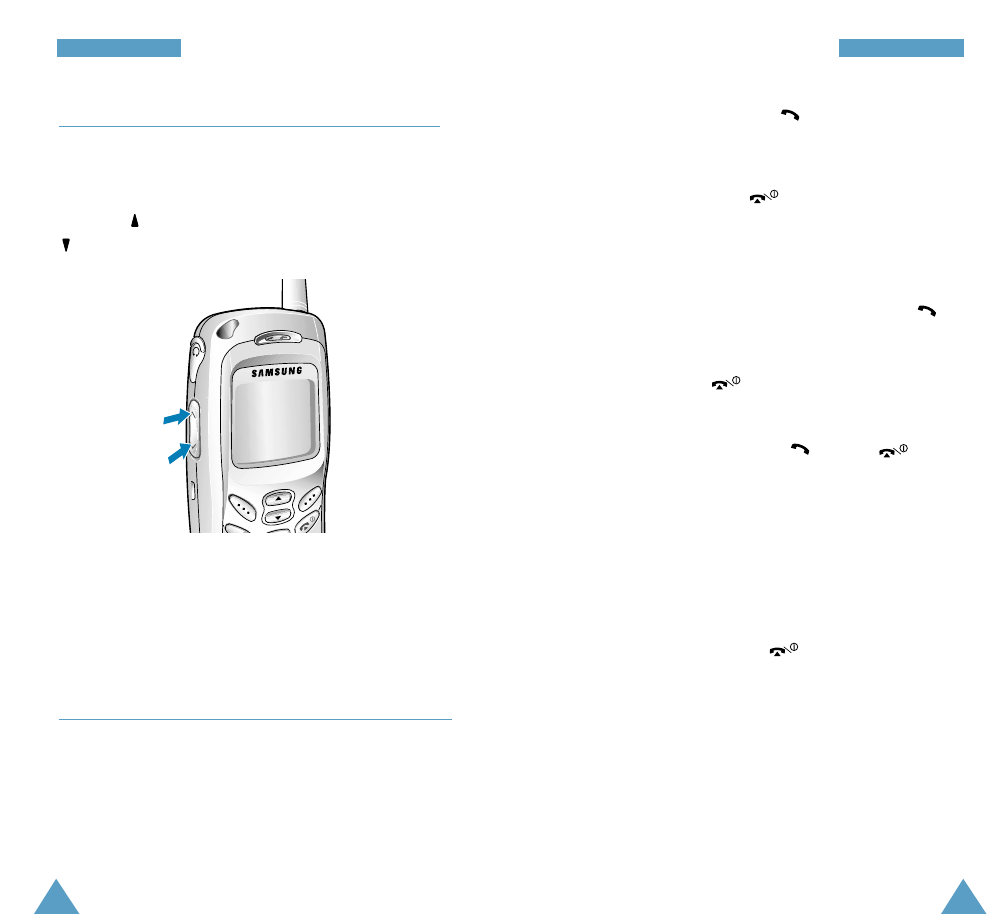
35
CCaallll FFuunnccttiioonnss
34
CCaallll FFuunnccttiioonnss
1. To answer a call, press the key.
If the Answer Mode menu option (Menu 8-1-1) is
set to Any Key, you can answer a call by pressing
any key except for the and the side volume key.
When the menu option is set to Folder Open, you
can simply open the folder to answer the call.
If the menu is set to Call Key, you must press
to answer the call.
When you press or the volume key once, when
a call is received, the phone stops ringing or
vibrating depending on the mode it is in. You can still
answer the call by pressing . Press twice
to disconnect without answering the call.
If the phone is closed, press and hold the volume key
to reject an incoming call.
For details about the Answer Mode menu option,
see page 102.
2. To end the call, press the key or simply close
the folder.
Notes:
• You can answer a call while using Phonebook or
menu functions. The current operation stops.
• If you cannot answer incoming calls, you can set the
phone to answer the call by playing a greeting
message and record callers’ messages. For further
details, see page 89.
Adjusting the Volume
During a call, if you want to adjust the voice volume,
use the volume keys on the left side of the phone.
Press the key to increase the volume level and the
key to decrease the level.
You can also adjust the keypad tone volume using these
keys in Standby Mode.
Answering a Call
When somebody calls you, the phone rings and displays
the incoming call animation.
If the caller can be identified, the caller’s phone number,
name, or image if available in your Phonebook, displays.

37
CCaallll FFuunnccttiioonnss
36
CCaallll FFuunnccttiioonnss
Using Caller ID
This feature tells you who is calling you by displaying
the caller’s number when the phone rings. If the name
and number are stored in your Phonebook, the
corresponding name also displays. If you call someone
who has this feature, your phone number displays on
her/his phone.
Note: Contact Reliance for more information on the
Caller Line Identification service.
Viewing Missed Calls
If you fail to answer a call for any reason, the phone
indicates the missed call by displaying a text notification
on the screen. Additionally, if caller information is
available, a missed entry is created.
Press the key to access the missed call list, or press
the key to clear the message and return to
Standby Mode.
To view missed calls, access the Missed menu option
(Menu 3-1) on page 71.
Options During a Call
Your phone provides you with a number of functions that
you can use during a call.
Press the Menu soft key during a call to access the
following options:
Phone Book: allows you to access the Phone Book
menu. For details, see page 53.
Mute/Quit: allows you to switch your phone’s
microphone off, so that the other person cannot hear
you.
Example: You wish to say something to another person
in the room but do not want the person at the other end
to hear you.
Silent/Quit: does not transmit the key tones. It allows
you to press keys without hearing annoying key tones
during a call.
Call History: allows you to access the Call History
menu. For details, see page 71.
Messages: allows you to use the Message feature.
For details, see page 61.
Organiser: allows you to access the Organiser menu.
For details, see page 92.
Voice Privacy: encrypts the voice channel so that
people cannot eavesdrop on your conversation. For
further details, see page 108.

39
CCaallll FFuunnccttiioonnss
38
CCaallll FFuunnccttiioonnss
Call Forwarding
When the Call Forward menu (Menu 8-1-3) is
enabled, your phone forwards incoming calls to another
phone number, even if your phone is turned off.
Activating Call Forwarding does not affect outgoing calls
made from this phone. For further details for activating
Call Forwarding, see page 103.
Note: Contact Reliance to activate/deactivate the Call
Forwarding service.
Call Waiting
You can answer an incoming call while you have a call
in progress, when the Call Waiting menu (Menu
8-1-4) is enabled. See page 104 for further details.
When a waiting call is detected, the incoming call alert
sounds, depending on your network, and a text
notification displays.
To answer a waiting call during a call:
1. When you hear a beep telling that you have a waiting
call, press the key. The phone connects the
calling person and places the current call on hold.
2. Press the key again to switch between the two
calls.
Note: If you do not respond to a Call Waiting
notification, the phone will forward the call to
voice mail server or another number that you
have set up. Contact Reliance for more
information.
Quickly Switching to the Vibrate Mode
Vibrate Mode disables all of the sounds on the phone.
This feature is best used in situations where the phone
might disturb others, such as in a meeting, at a library or
in a theater. You can switch your phone to the vibrate
mode with one touch of a key.
In Standby Mode, press and hold the key until
“Enter! Vibrate Mode” and the Vibration indicator in red
color ( ) display.
To exit and reactivate the previous sound settings, press
and hold the key again until “Exit! Vibrate Mode”
appears. The Vibration indicator no longer displays.
Quickly Switching to the 1-Beep Mode
You can switch your phone to the 1-Beep Mode with
one touch of a key.
In Standby Mode, press and hold the key until
“Enter! 1-Beep Mode” appears.
To exit and reactivate the previous sound settings, press
and hold the key again until “Exit! 1-Beep Mode”
appears.

4140
CCaallll FFuunnccttiioonnssEntering Text
At many times when using your phone, you will need to
enter text; for example, when storing a name in
Phonebook, creating your personal greeting or
scheduling events on your calendar. You can enter
alphanumeric characters into your phone using your
phone’s keypad.
Your phone has the following text input modes:
• T9(English): This mode allows you to enter words
with only one key press per letter. Each key on a
keypad has more than one letter - a single press on
the 5key could be J,K or L. The T9 mode
automatically compares your key presses to an
internal linguistic database to determine the correct
word. The T9 mode requires far fewer keystrokes than
the traditional multi-tap method, alphabet mode.
• Alphabet: This mode allows you to enter letters by
pressing the key labeled with the letter you want to
enter once, twice, or three times until it appears on
the display.
• Symbol: This mode allows you to enter special
characters.
• Number: This mode allows you to enter numbers.
Note: The T9 mode supplies an appropriate language
database as your language setting menu (Menu
5-1). T9 mode is available only in English. For
further details about entering text Hindi
characters, see Hindi User’s Manual.
Three-Way Calling
This feature enables you to conduct conference calls
with two separate persons at the same time. The phone
records each participant into the Dialled Calls Log. Also,
You are billed call time for each outgoing call
separately.
Note: Contact Reliance for activating Three-Way Calling
and for information on how to place a Three-Way
Call.

43
EEnntteerriinngg TTeexxtt
42
EEnntteerriinngg TTeexxtt
Changing the Text Input Mode
When you are in a field that allows characters entry, you
should notice the text input mode indicator on the
display.
Example: Entering a name for a Phonebook entry
To change to another text input mode:
1. Press the Options soft key.
2. Scroll to the mode by pressing the or key.
3. To select the highlighted mode, press the Select soft
key. If you want to exit the menu without changing to
a new mode, press the CLR key.
The selected text input mode indicator appears on the
display.
Text input mode
indicator
Using the T9 (English) Mode
To type a word, press keys corresponding to the letters
you need. Remember the following as you are typing:
1. Press alphanumeric keys on the keypad just once per
letter. For example, to enter “Hello”, press the 4, 3,
5, 5and 6keys.
The word you are typing appears on the display. It may
change with each key press.
2. Type to the end of the word before editing or deleting
any keystrokes.
3. Put a space between words by pressing the key.
If the word that appears on the display is not the
word that you desire, press 0key one or more times
to display alternative word choices for the keys you
have typed. For example, both “of” and “me” have
the sequence of the 6key and 3key. The phone
displays the most commonly used choice first.
4. Continue entering the next word.
Smart Punctuation
Periods, hyphens, and apostrophes are available by
pressing the 1key. The T9 mode applies rules of grammar
to insert the correct punctuation. Notice that the 1key is
used twice in this example to display two punctuation
marks:
L e t ‘ s e a t .
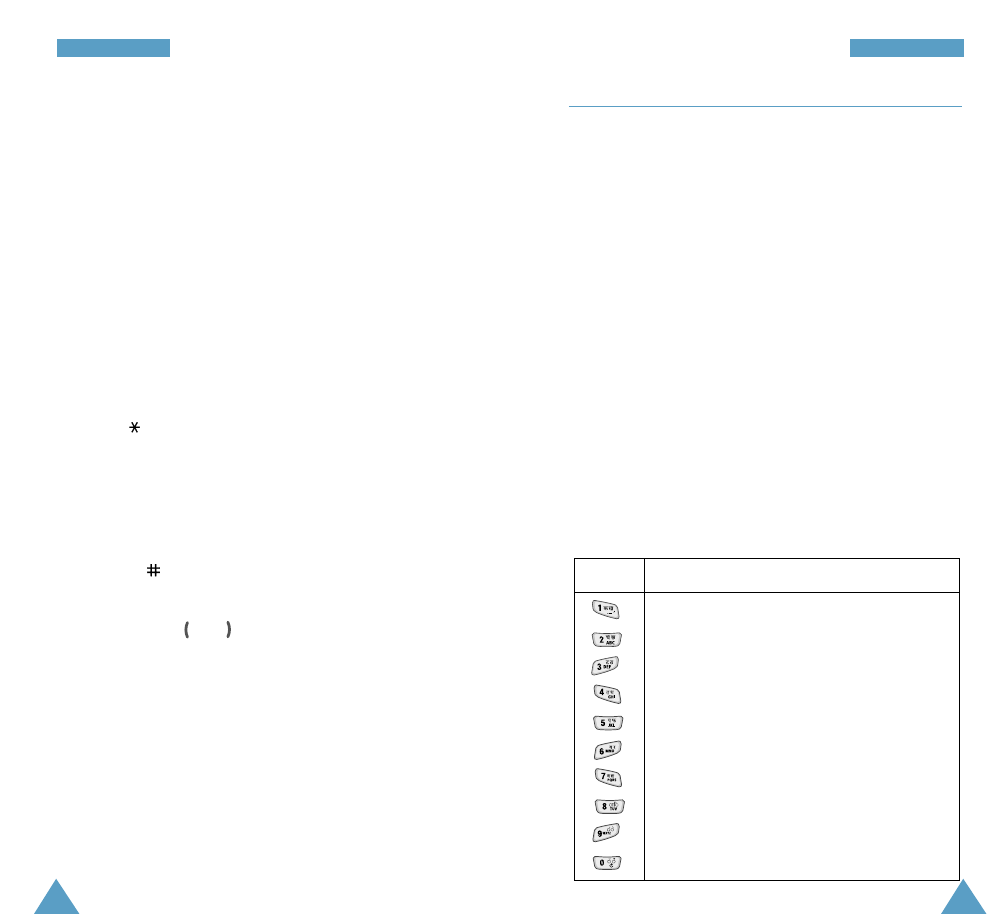
45
EEnntteerriinngg TTeexxtt
44
EEnntteerriinngg TTeexxtt
Including a Number
You can include a number between letters without
exiting the T9 input mode. Press and hold the
corresponding number key.
Changing the Case
Your phone offers three cases:
• T9: initial letter is capitalized.
• T9: all letters are capitalized.
• t9: all letters are lower case.
Press the key one or more times to display the
appropriate case indicator on the top right of the display
and begin typing normally.
Another Usage
• Press the key to insert a space.
• To move the cursor to the left or right through your
text, press the or key.
• Press the CLR key one or more times to delete the
letters one by one to the left. Press and hold the CLR
key to clear the display.
Using the Alphabet Mode
When typing in the alphabet mode, you need to press
the keys labeled with the required letter:
- once for the first letter
- twice for the second letter
- and so on.
This method is called multi-tap typing.
For example, you press the 2key three times to display
the letter “C” and the 5key two times to display the
letter “K.”
The cursor moves to the right when you press a different
key. When entering the same letter twice or a different
letter on the same key, just wait for a few seconds for
the cursor to move to the right automatically, and then
enter the next letter.
Refer to the table below for the list of characters
assigned on each key.
(Caps Lock mode)
. , - ? ! ’ @ : 1
AB C2
DE F 3
GH I 4
JK L5
MN O 6
PQ RS7
TU V8
WX Y Z 9
0
Key Characters in the Order Displayed
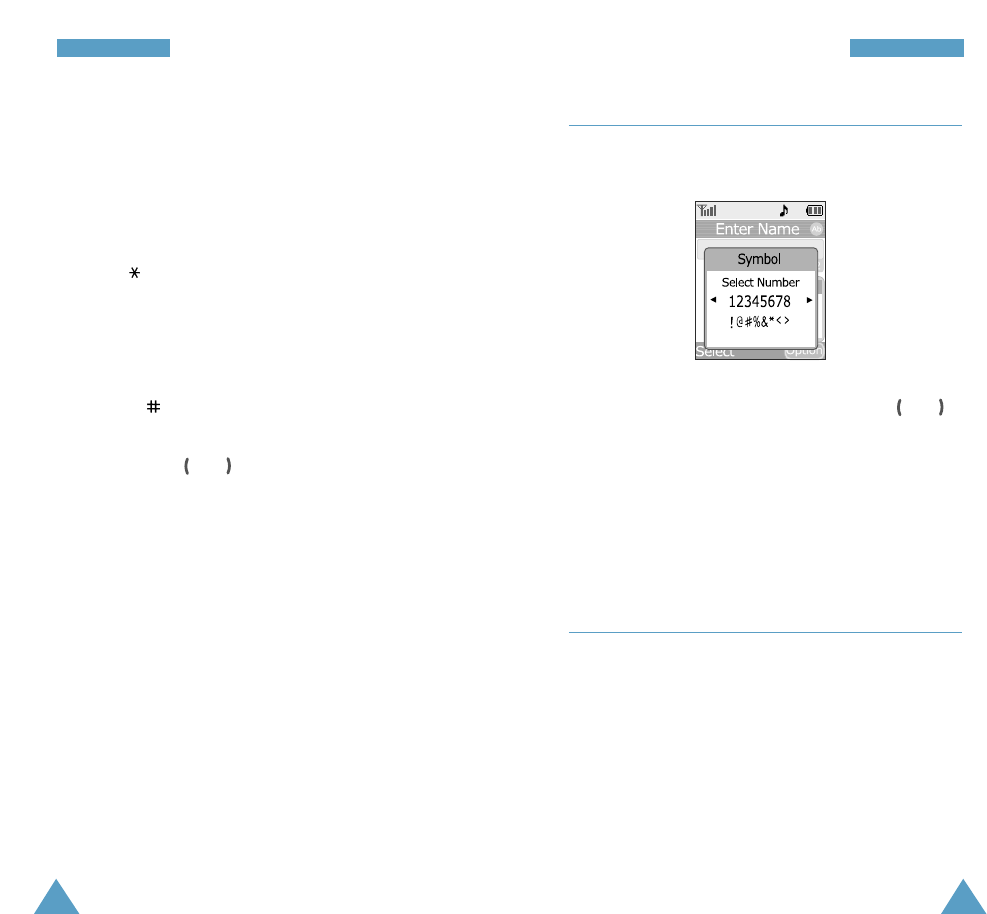
47
EEnntteerriinngg TTeexxtt
46
EEnntteerriinngg TTeexxtt
Changing the Case
Your phone offers three cases:
• Ab: initial letter is capitalized.
• AB: all letters are capitalized.
• ab: all letters are lower case.
Press the key one or more times to display the
appropriate case indicator, and begin typing normally.
Another Usage
• Press the key to insert a space.
• To move the cursor to the left or right through your
text, press the or key.
• Press the CLR key one or more times to delete the
letters one by one to the left. Press and hold the CLR
key to clear the display.
You can display more symbols by pressing the or
key.
Press the number key corresponding to the symbol you
want to enter. The phone automatically switches back to
the text entry mode used just prior to selecting the
symbol mode.
Using the Number Mode
The number mode enables you to enter numbers.
Press the keys corresponding to the digits you want to
enter and manually switch back to the text entry mode
of choice. For details about changing the mode, see
page 42.
Using the Symbol Mode
The symbol mode enables you to enter symbols.

49
UUssiinngg tthhee MMeennuuss
48
Using the Menus
This phone offers a range of functions that allow you to
tailor the phone to your needs. These functions are
arranged in menus and submenus.
The menus and submenus can be accessed by scrolling
or by using the shortcuts.
Accessing a Menu Function by Scrolling
1. In Standby Mode, press the Menu soft key to access
Menu Mode.
2. Scroll with the navigation keys to reach the desired
main menu; for example, Display. Press the Select
soft key to enter the menu.
3. If the menu contains any submenus; for example,
Language, find the one you want by scrolling with
the or key. Press the Select soft key to
enter the submenu.
If the menu you have selected contains submenus,
repeat this step.
4. Scroll with the or key to find the setting of
your choice.
5. Press the OK or Save soft key to confirm the chosen
setting.
Notes:
• You can return to the previous menu level by pressing
the CLR key or the Back soft key.
• You can exit the menu without changing the menu
settings by pressing the key.
Accessing a Menu Function by Using its
Shortcut
Menu, submenus and setting options are numbered and
can be quickly accessed by using their shortcut numbers.
Note: The numbers assigned to each menu function are
indicated on the list on page 50.
1. In Standby Mode, press the Menu soft key to access
Menu Mode.
2. Within three seconds, enter the first digit of the
shortcut number. Repeat this for each digit of the
shortcut number.
Example: Accessing the Language menu option
Press the 5and the 1keys.
5selects Display and 1selects Language.
3. Find the setting of your choice by pressing the or
key.
4. Press the OK or Save soft key to confirm the chosen
setting.

51
UUssiinngg tthhee MMeennuuss
50
UUssiinngg tthhee MMeennuuss
List of Menu Functions
Main menu Main menu 1 Main menu 2
1. Phone Book 1. Find
2. Add Entry
3. Groups 1. No group
2. Friends
3. Family
4. Colleague
5. VIP
6. Default 1~5
4. Memory Status
2. Messages 1. Write
2. Inbox
3. Outbox
4. Saved
5. Templates
6. Erase Messages 1. Inbox
2. Outbox
3. Saved
4. All Messages
5. Voice Mail
7. Settings 1. Auto Scroll
2. Msg Reminder
3. New Message
4. Msg Colour Setup
8. Voice Mail
3. Call History 1. Missed
2. Received
3. Dialled
4. Erase History 1. Missed
2. Received
3. Dialled
4. All
5. Call Duration 1. Last Call
2. Total Dialled Calls
3. Total Receive Calls
4. Reset All
5. Life Time
Main menu Main menu 1 Main menu 2
4. Sound 1. Ring Tones 1. Calls
2. Messages
3. Schedules
2. Ringer Volume 1. Calls
2. Messages
3. Alarm/Schedules
3. Alerts 1. Call Connect
2. Call Disconnect
3. Privacy
4.Key Tone 1. Tone Volume
2. Type
3. Tone Length
5.Power On/Off Melody
5. Display 1. Language
2. Service Area
3. Menu Theme
4. Wallpaper 1. Image Wallpaper
2. Photo Wallpaper
5. Banner
6. Backlight
7. Set Dual Clock
8. Service LED
9. Contrast
6. Organiser 1. Scheduler 1. Today
2. All
2. Task List
3. Memo Pad
4. Alarm 1. Daily Alarm
2. Weekly Alarm
5. Calculator
6. World Time
7. Countdown

5352
UUssiinngg tthhee MMeennuuss
Main menu Main menu 1 Main menu 2
8. Settings 1. Call 1. Answer Mode
2. Auto Redial
3. Call Forward
4. Call Waiting
2. Phone/System 1. Key Guard
2. Set Time
3. Set NAM
4. Version
3. Security 1. Lock Mode
2. Change Code
3. Emergency Numbers
4. Voice Privacy
5. Clear Phone Book
6. Reset Phone
9. R World 1. R-Menu
2. Multimedia
3. Games 1. Fun Bowliing
2. Hamster Box
3. Honey Bust
4. Reset R-Menu
0.Camera 1. Take Photo 1. Camera
2. Multi-Shot
2. Photo Album
3. Photo Wallet
4. Settings 1. Lock Photo Review
2. Quality
Phone Book
Phonebook allows you to store frequently used phone
numbers and the associated names in your personal
directory to make it easy for you to make a call without
having to remember or enter the phone number. You can
store up to 700 entries including e-mail and URL
addresses.
Find Menu 1-1
This option allows you to find an entry in your
Phonebook.
Note:You can access this menu by pressing the Find
soft key in Standby Mode.
1. Press the or key to scroll to the method you want
to use.
• By Name: Enter the first few letters of the name
you want with the alphabet mode. The Phonebook
entries are listed starting with the first entry
matching your input.
• By Entry: Enter the location number of the number
your want to find, using the numeric keys.
• By Group: Press the key and select the group
containing the entry you want to find, using
the or key. The phone lists all of the entries in
the selected group.
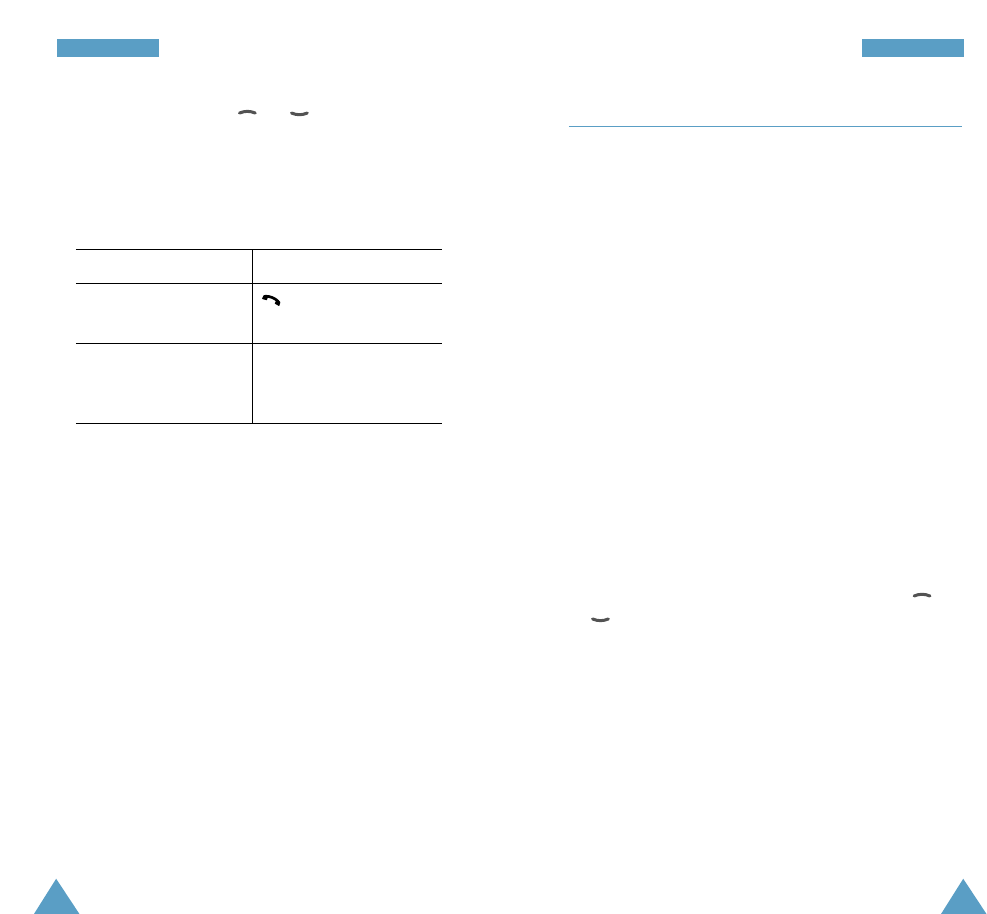
54
PPhhoonnee BBooookk
55
PPhhoonnee BBooookk
2. If necessary, press the or key to scroll
through the entries.
3. When the entry you want highlights, press the Select
soft key to access the entry. The phone shows the
details about the name.
4. To Press the
place a call to key or the Call
selected number soft key.
use the options Options soft key. For
details about the options,
see below.
When you press the Options soft key in the details
display, the following options are available:
Edit: allows you to change the phone number, name,
location number, label category and many others.
Prepend: allows you to add digits, such as area codes,
ahead of the selected number before dialing. See page
28 for details.
Erase: erases the selected entry.
Add Entry Menu 1-2
This menu allows you to store a number with a name in
your Phonebook. You can save a person’s numbers, such
as home number, office number, mobile number, and fax
number, into one entry. A Phonebook entry can contain
up to six numbers, one in each category.
Add Number (Menu 1-2-1)
1. Enter a phone number and press the Save soft key.
2. Press the Select soft key to confirm to add a new
entry.
3. Enter a name and press the Next soft key. For further
details about entering characters, see page 41.
4. Select an icon to identify the category of number to
be stored using the navigation keys and press the
Select soft key.
5. To select an option, scroll to it by pressing the or
key.
The following options are available:
• Enter Name: allows you to enter a name of up to
12 characters, if you didn’t in step 3. For further
details about how to enter text, see page 41.
• Entry: The first available location displays. If
necessary, enter the location number using the
number keys.

56
PPhhoonnee BBooookk
57
PPhhoonnee BBooookk
• Home/Office/Mobile/Pager/Fax/No label:
allows you to store more numbers for each
category.
• Speed dial: allows you to select one of the stored
numbers for speed dialling.
• E-mail: allows you to store an e-mail address.
• URL: allows you to store a URL address.
• Group: allows you to assign an entry to a caller
group. To remove the entry from a group, select No
Group.
• Name Ringer: allows you to select the unique
ringer to be used for alerting you to an incoming
call from the person.
• Birthday: allows you to save the date of the
person’s birthday.
• Secret: allows you to prevent a number from being
displayed when it is accessed or dialled by
unauthorized users. When this option is set to ON,
only people with your phone’s lock code can view
the secret number.
• Image: allows you to select an image to be used
for alerting you to an incoming call from the
person.
6. Press the Edit soft key to enter information or use the
or key to change the setting.
7. When you finish setting the options, press the Save
soft key to store the entry.
After storing, the phone displays the Phonebook entry
number that you just saved and the remaining slots you
can further store phone numbers.
Add Email (Menu 1-2-2)
Using this menu, you can save an e-mail address.
1. Enter an e-mail address and press the Next soft key.
For further details about entering characters, see
page 41.
2. Enter a name and press the Next soft key.
3. To complete storing the e-mail address, follow the
procedure from step 5 in “Add Number” on page 55.
Add URL (Menu 1-2-3)
Using this menu, you can save a URL address.
1. Enter an URL address and press the Next soft key.
For further details about entering characters, see
page 41.
2. Enter a name and press the Next soft key.
3. To complete storing the URL address, follow the
procedure from step 5 in “Add Number” on page 55.

PPhhoonnee BBooookk
5958
Storing Phone Numbers at Call’s End
To store a phone number at the end of your call:
1. Press the key to end the call. The call time and
the phone number display.
2. To store the phone number, press the Save soft key.
3. To complete storing the number, follow the procedure
from step 2 in “Add Number” on page 55.
Adding a Number into an Existing Entry
1. Enter a number and press the Save soft key.
2. Scroll to the entry where you want to add a number
by pressing the or key. Press the Select soft
key.
3. To complete storing the number, follow the procedure
from step 4 in “Add Number” on page 55.
PPhhoonneebbooookk
Groups Menu 1-3
This option allows you to change the settings for the
caller groups.
To change a ringer melody indicated when a call comes
in from a member of a group:
1. Press the or key to scroll to the group you
want to edit.
2. Press the Ringer soft key.
3. Select the ringer category you want by pressing the
or key and press the key.
4. Select the ringer melody you want by pressing the
or key.
5. Press the Select soft key.
To change the name of a caller group:
1. Press the or key to scroll to the group you
want to edit.
2. Press the Rename soft key.
3. Press the CLR key to clear the current group name.
4. Enter a new name and press the Save soft key.
For further details about entering characters, see
page 41.

60
PPhhoonnee BBooookk
61
Messages
Your phone can receive voice mail notification and text
messages. It also can send text messages and pages if
you service provider provides this service.
When the phone receives a message, an alert sounds, a
text notification displays along with the name and
phone number of the caller if available. The New
Message icon ( ) remains on the screen until you read
the new text messages or numeric pages, or you listen
to the new voice mail messages.
Messages are received even when your phone is in the
lock mode. However, the screen does not display
information about the message. To access a message,
you must unlock the phone.
If you receive an incoming message during a
conversation, your phone automatically mutes the ringer.
This is to avoid ringing in your ear while you are trying
to converse.
You can quickly enter the Messages menu by pressing
the key in Standby Mode.
Write Menu 2-1
You can create a short text message up to 140
characters and send it to other mobile phones.
Note: Message transmission is available only when
your phone is operating in a digital network and if
service is supported by Reliance.
Contact Reliance for more information.
Memory Status Menu 1-4
This option shows you how many Phonebook locations
are used or empty.
After displaying, the phone automatically goes back to
the previous menu level.

63
MMeessssaaggeess
62
MMeessssaaggeess
1. Enter the message contents and press the Next soft
key. For further details about how to enter text, see
page 41.
Press the Options soft key and select Templates to
add a template message.
2. Enter a destination number using the numeric keys.
Pressing the Ph Book soft key allows you to search
your phonebook for a number. You can retrieve one of
the numbers stored in the phonebook.
3. To send the message to multiple destinations, press
the key to insert a space and repeat from step 2.
4. When you finish entering, press the Next soft key.
5. To select an option, press the or key.
The following options are available:
• Msg: press the Edit soft key to change the
message contents you’ve already entered.
• Send To: press the Edit soft key to change the
send-to phone number.
• Settings: press the Edit soft key to change the
message setting. Scroll to an option using the
or key and change the setting using the or
key. The following options are available:
- Priority: select the message priority.
- Validity: select how long your message is valid at
the SMS center while attempts are made to
deliver them to the recipients.
- Send Later: select how long the delivery of the
message will be delayed at the SMS centre, if you
do not want to send it immediately.
- Delivery Ack: turn the delivery acknowledgement
feature on or off. When this is activated, the
network informs you whether or not your message
has been read by the recipients.
- Save Message : set whether or not the phone
saves the message in the Outbox after
transmission. When you select Prompt Save, the
phone will ask if you want to save the message.
Note: The Delivery Ack and Save Message options
can be preset in the New Msg menu option
(MENU 2-7-3); for details, see page 68.
• Save Msg: press the Save soft key to store the
message contents in the Saved menu for future
use.
6. Repeat step 5 to set the message options.
7. After changing the setting options, press the key
or the Send soft key to send the message.
Note: Closing the folder or pressing the key
before the message is sent stops the
transmission.

65
MMeessssaaggeess
64
MMeessssaaggeess
Inbox Menu 2-2
Your phone can store up to 98 messages total in the
Inbox, Outbox and Saved message box. When the
memory is full, a warning message displays and the
phone rejects additional messages until you erase the
obsolete ones.
When you access the Inbox menu option, the message
list appears.
To view a message, press the or key to scroll to
it and press the Select soft key.
If necessary, press the or key to scan through
the contents. You can move to the next or previous
message by pressing the or key.
While viewing a message, press the Reply soft key to
send a reply message to the sender.
Press the Options soft key to use the following options:
Erase: erases the message from Inbox.
Forward: allows you to forward the message to another
person.
Call: places a call to the callback number.
Save: allows you to save the callback number of the
message.
Outbox Menu 2-3
Your phone can store up to 98 messages total in the
Inbox, Outbox and Saved message box.
When you access the Outbox menu option, the
message list appears.
To review a message, press the or key to scroll
to it and press the Select soft key.
If necessary, press the or key to scan through
the contents. You can move to the next or previous
message by pressing the or key.
While reviewing the message:
• Press the Resend soft key to send the message
again. For more information about sending a message,
see page 61.
• Press the Erase soft key to erase the message from
the Outbox.
• To make a call to the recipient’s number of the
message, press the key. If necessary, select a
number on the callback list and press the key
again or the Call soft key to dial the number, or the
Save soft key to save it in Phonebook.

66
MMeessssaaggeess
67
MMeessssaaggeess
Saved Menu 2-4
Your phone can store draft messages that are yet to be
sent in the Saved message box. If you save the message
contents using the Save Msg menu option before
sending it (see page 63), you can access them using this
menu.
While reviewing the message:
• Press the Send soft key to send the message again.
For more information about sending a message, see
page 61.
• Press the Erase soft key to erase the message from
the Saved box.
• To make a call to the recipient’s number of the
message, press the key. If necessary, select a
number on the callback list and press the key
again or the Call soft key to dial the number, or the
Save soft key to save it in Phonebook.
Templates Menu 2-5
Using this menu, you can preset up to ten message
templates that you use most frequently and use them
when you send a message.
Scroll to the message you want by pressing the or
key.
• Press the Select soft key to send the message using
the templete. For further details about how to send a
message, see page 61.
• Press the Edit soft key to change the message. For
further details about how to enter characters, see
page 41.
Erase Messages Menu 2-6
Using this menu option, you can erase all of the
messages in each message box. You can also erase all
of the messages at one time by selecting All
Messages.
When a confirming message appears, select Yes and
press the OK soft key.

69
MMeessssaaggeess
68
MMeessssaaggeess
Settings Menu 2-7
In this menu, you can preset several options for using
the messaging feature.
Auto Scroll (Menu 2-7-1)
If a message is too long for the display, the phone
displays it by scrolling the screen automatically. You can
set how often the phone scrolls the message to the next
screen.
If you select Off, you need to scroll to the next screen
manually using the or key.
Message Reminder (Menu 2-7-2)
When a message is received, the phone alerts you by
sounding the selected ringer. You can set how often you
want to be alerted. Selecting Off means that the
message alert sounds once when the message is
received. Selecting Once means that the message alert
sounds once when the message is received and sounds
again after 2 minutes. Selecting Every 2 min means
that the message alert sounds every 2 minutes.
New Message (Menu 2-7-3)
You can set up the default settings of the options for
creating a new message.
The following options are available:
Save Message: allows you to set whether or not you
want the transmitted message to be saved in Outbox.
- Do not Save: the phone does not save the message.
- Prompt Save: the phone asks you if you want to save
the message or not.
- Auto Save: the phone automatically saves the
message.
Entry Method: allows you to select the text input mode
between T9 Word (T9 English) and Alphabet .
Delivery Ack: allows you to activate or deactivate the
delivery acknowledgement.
Message Colour Setup (Menu 2-7-4)
This menu option allows you to change the color of the
text or background of your outgoing messages.
1. Press the or key to select a color for the
message text.
The display shows your color setting.
2. Press the key to select the message background.
Press the or key to select a color for the
message background.
The display shows your color setting.
3. Press the Save soft key to save your setting.
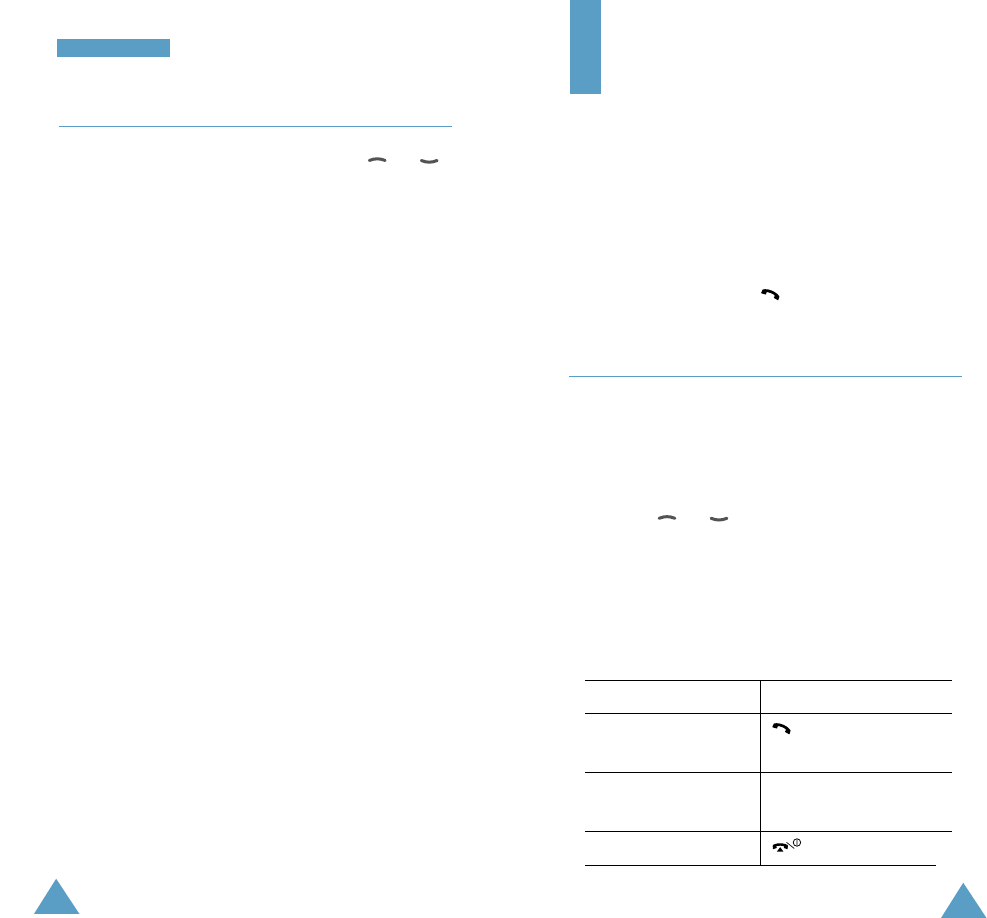
71
70
MMeessssaaggeess
Voice Mail Menu 2-8
When the voice mail list displays, press the or
key to scroll to a voice message and press the Select
soft key to review the message.
When multiple new voice messages are received but
reviewed them, information of the last one displays. The
information display includes the time/date stamp, the
number of new voice messages and the callback
number.
While reviewing the message, press the soft key to
access the following options:
Listen: allows you to listen to the voice message. The
phone automatically dials the number of your voice mail
centre.
Reset: clears the New Message icon and resets the
counter for a new voice message, if necessary. The
system resets the counter automatically after you listen
to all of the new messages.
Call History
You can use the Call History menu to:
• view and dial the last calls you dialed, received or
missed.
• erase the numbers in the call log memory.
• view the length of calls.
Note: You can also access the numbers in the three call
type by pressing the key in Standby Mode.
Missed Menu 3-1
If Caller Line Identification service is available, your
phone keeps a list of the last 10 incoming calls that you
failed to answer. Contact Reliance for more information
about the service.
1. Press the or key to find a number, or name if
it is saved in Phonebook.
2. Press the Select soft key to confirm the highlighted
number. The missed number, or name if it is saved in
Phonebook, displays along with the date and time
when the call was received.
3. To Press the
place a call to key or the Call
the number soft key.
use the options Options soft key. For
details, see the next page.
exit the call log key.

72
CCaallll HHiissttoorryy
73
CCaallll HHiissttoorryy
When you press the Options soft key on the call log
list, the following options are available:
Save: (shown when the number is not stored in your
Phonebook) allows you to save the number in
Phonebook.
Show Entry: (shown when the number is stored in your
Phonebook) shows you the Phonebook location number.
Edit: allows to change the phone number to dial it or
save it in Phonebook.
Erase: erases the selected number.
Send Msg: allows you to send a message to the
number. For details about sending a message, see page
61.
Received Menu 3-2
This option lets you view up to 10 of the last calls you
received if you are subscribed to the Caller Line
Identification service. Contact Reliance for more
information about this service.
When you access this menu, a list of the calls you
received displays.
For more information about scrolling through the list and
accessing the call log, see “Missed” on page 71.
Dialled Menu 3-3
The phone stores up to 10 of the last calls you dialled.
When you access this menu, a list of the outgoing calls
displays.
When you access this menu, a list of the calls you
dialed displays.
For more information about scrolling through the list and
accessing the call log, see “Missed” on page 71.
Erase History Menu 3-4
You can erase the entries stored in each of the three call
logs or all three logs at once.
When a confirming message displays, select Yes to
erase the selected log or all of the logs. If you want to
cancel the selection, select No. Press the OK soft key to
confirm the selection.

74
CCaallll HHiissttoorryy
75
Call Duration Menu 3-5
Your phone records the amount of air time, or talk time,
used. Using this option, you can view the number of the
calls to or from your phone, and the air time for all of
the calls. You can easily erase the call time record at
any time. This option is convenient for estimating your
usage.
Note: This feature is not intended to be used for billing
purposes.
The following options are available:
Last Call: shows the time of the last call.
Total Dialled Calls: shows the number of all calls you
made and the total duration of the calls since the time
counter was last set to zero by using the Reset All
option.
Total Received Calls: shows the number of all calls
you received and the total duration of the calls since the
time counter was last set to zero by using the Reset All
option.
Reset All: erases the last call, the “Total
Received/Dialled Calls” time measurements, and resets
the air time counters.
Life Time: shows the number and total duration of all
calls made to or from your phone since the phone was
shipped from the factory.
Sound
Note: You can quickly enter this menu by pressing
in the standby mode.
You can use the Sound menu to customize various
sound settings, such as the:
• ringer volume, type, and tone.
• key tone and alert sounds.
• sound which plays when the phone is switched on or
off.
Ring Tones Menu 4-1
This option allows you to set the unique ringer melodies
for the following items:
Calls: allows you to set a unique ringer for incoming
voice calls.
Messages: allows you to have a distinctive ringer for
incoming text messages and voice mail independently.
Schedules: allows you to have a distinctive ringer for
alarm settings.
Select a unique ringer melody using the navigation keys.
After you change it, it plays for a few seconds.

77
SSoouunndd
76
SSoouunndd
Alerts Menu 4-3
Your phone gives audible alerts (beeps) at a specified time
to inform you that certain things have happened. The alerts
only occur in your earpiece so that the other person does
not hear them.
The available alerts are:
Call Connect: when this option is set to On, the phone
sounds the connect tone when your call is connected to the
system.
Call Disconnect: when this option is set to On, the phone
sounds the disconnect tone when a call is disconnected.
Privacy : when this option is set to On, the phone sounds
an audible beep when you loose a private encrypted CDMA
line. For this option to work correctly, you must have the
enhanced privacy option set in the Security options.
Notes:
• You can also enable the Privacy mode option during a
call secure. Simply enable the Privacy mode from the In
Use Menu while connected to a call.
when this option is enabled and you are located in an area
that supports the privacy option, the Privacy icon is
displayed at the top of the screen. Unless you are located
in an area that supports privacy, a outlined privacy icon is
displayed .
Ringer Volume Menu 4-2
This menu option allows you to adjust the ringer
volume.
Calls: allows you to adjust the ringer volume for
incoming voice calls.
Messages: allows you to adjust the ringer volume for
incoming messages.
Alarm/Schedules: allows you to adjust the ringer
volume for alarm settings or scheduled events.
Press the navigation keys to adjust the volume level or
select a ringer type. The following options are available:
- Light: the phone does not sound a ring.
- Vibrate: the phone switches to the vibration mode. An
incoming call vibrates the phone.
- 1-Beep: the phone sounds a beep.
- Level 1 ~ 8: adjust the volume level. The more bars,
the louder.
- High+Vib: the phone sounds at level 8 and vibrates at
the same time.
Notes:
• The options available may be different depending on
the selected ringer item.
• When “Emergency call only” appears after you end an
emergency call, the ringer volume for calls and
messages is automatically set to Level 4.

78
SSoouunndd
79
Key Tone Menu 4-4
In this menu, you can set up the sound your phone
generates when you press a key.
The following options are available:
Tone Volume: adjusts the volume using the navigation
keys or the volume keys on the left side of the phone.
Note: When “Emergency call only” appears after
ending an emergency call, the key tone is
automatically set to Level 4.
Type: allows you to select the type of key tone. Choose
one of Beep, Drum, Rain Drop, and Lady’s Voice.
Tone Length: enables you to select Short or Long
DTMF (dual-tone multi-frequency) tones. DTMF tones
are sent by your phone to access teleservices, such as a
bank account. The system used by the bank or other
service determines if you need short or long DTMF
tones. If the service is digital, as most are, short DTMF
tones will almost always work.
Power On/Off Melody Menu 4-5
You can turn on or off the melody that the phone plays
when it is switched on or off.
Choose On to use the power on/off sound or Off not to
use it.
Display
The Display feature enables you to customize various
settings for the display and the light.
Language Menu 5-1
This menu option allows you to change the language of
voice prompts, menus and key input.
You can choose a language either English or Hindi.
Note: This setting does not affect R World applications.
Service Area Menu 5-2
This menu displays the current service area the user is
in. The service area is also displayed for about 5
seconds when your phone is registered onto a network
or when you make or receive a call.

80
DDiissppllaayy
81
DDiissppllaayy
Banner Menu 5-5
This option allows you to set a banner message to be
displayed at the bottom of the display in Standby Mode.
1. If necessary, press the CLR key to delete each letter
of the old greeting. Press and hold the CLR key to
clear the display.
2. Enter your banner message of up to 15 characters.
For further information about how to enter characters,
see page 41.
3. When you finish entering the message, press the
Next soft key.
The screen allowing you to change the banner color
appears.
4. Press the or key to change the color for the text
font and press the key.
5. Press the or key to change the color for the text
shadow and press the Save soft key.
Menu Theme Menu 5-3
This options allows you to select the menu display style.
You can choose a style between Camera and Nature.
Wallpaper Menu 5-4
You can change the background image (wallpaper) to be
displayed in Standby Mode.
On the Image Wallpaper list, you can select one from
the default animation images and downloaded images.
In addition, you can choose Digital Clock, Analog
Clock or Dual Clock.
When you select Dual Clock, the phone displays the
analogue clocks for the two time zones selected in the
Set Dual Clock menu option (Menu 5-7). See page 83.
On the Photo Wallpaper list, you can choose from the
photos you took using the camera on your phone.
If the wallpaper is chosen from photo wallet, banner
and date will disappear in 7 seconds after opening the
folder. Press shortly CLR key to show up the display.
Press long CLR key to make the display vanish before 7
seconds.
Note: To view your photos on this list, you need to set
them as a wallpaper in the Photo Wallet menu
option (Menu 0-3). See page 121.

82
DDiissppllaayy
83
DDiissppllaayy
Backlight Menu 5-6
You have several options for setting how the LCD
backlight operates. Remember that backlight use drains
your battery faster.
The following options are available:
Always on: The backlight remains on when the folder
is open.
30 seconds: The backlight switches on when you press
a key or open the folder and switches off 30 seconds
after that. The display finally turns off after another 30
seconds.
8 seconds: The backlight switches on when you press a
key or open the folder and switches off 8 seconds after
that. The display finally turns off after another 52
seconds.
Dimming: The backlight switches on when you press a
key or open the folder and then dims. It switches off 60
seconds after that.
Set Dual Clock Menu 5-7
You can choose two time zones to be displayed when
you select Dual Clock for the wallpaper image; for
details, see page 80.
To select time zones for the dual clock:
1. When Location is highlighted, press the key.
2. Select the time zone for the first clock by pressing
the or key and press the key.
3. Select the time zone for the second clock by pressing
the or key
4. Press the Save soft key to confirm the selection.
To apply the daylight saving time:
1. When Location is highlighted, press the or key
to display DST. Press the key.
2. Select Yes to use the daylight saving time for the first
clock. Otherwise, select No.
3. Press the key and repeat step 2 for the second
clock.
4. Press the Save soft key to confirm the selection.
Service LED Menu 5-8
This option allows you to select whether or not the
service light on the folder is used.
Contrast Menu 5-9

84 85
OOrrggaanniisseerr
Organiser
The Organiser feature enables you to:
• keep track of important dates and events.
• create a list of things to do and memos of things you
need to remember.
• set an alarm to ring at a specific time.
• use the phone as a calculator.
• check the time in another part of the world.
Scheduler Menu 6-1
In this menu, you can keep track of your daily or monthly
schedule.
Today (Menu 6-1-1)
You can schedule up to 9 events for the current day,
indicating each event’s start and end time. You can even
have your phone's calendar alert you before an event
commences. Events scheduled for future dates
automatically appear on your Today events schedule on
that day.
Scheduling a New Event
1. Enter your event contents and press the Next soft
key. You can enter up to 32 characters in a new event.
For further details about how to enter characters, see
page 41.
2. Enter the start time and date using the numeric keys.
Note: You can move through the input fields using the
navigation keys.
3. Enter the end time and date using the number keys.
You need to enter the time in 24-hour format.
4. Select when an alarm will inform you of the event, by
pressing the or key. Selecting No Alarm means
that the phone does not ring the alarm.
5. Press the Save soft key to store your event.
Viewing Your Today’s Schedule
The list of the events stored on the current day displays
when you select the Today menu option (Menu 6-1-1).
While viewing the schedule list, press the or
key to scroll to an event and:
• To view details, press the View soft key. To view the
Start and End time settings, use the or keys.
You can move to the previous or next event by
pressing the or key.
While viewing the event, press the Edit soft key to
change the event, or press the Erase soft key to erase
the event.
• Press the Options soft key to use the following
options:
Add New: allows you to add a new event.
Erase : allows you to erase the event.
Erase All: allows you to erase all of the events.

86
OOrrggaanniisseerr
87
OOrrggaanniisseerr
All (Menu 6-1-2)
This option allows you to view the current month, as
well as past or future months, in calendar format. On
the calendar, the current day is black and days with
scheduled events are indicated by a box inside the
calendar day.
Note: You can quickly access this menu by pressing the
key in Standby Mode.
Scrolling Through the Calendar
• You can move left or right by one day by pressing
the or key.
• You can move up or down by one week by pressing
the or key.
• To display the next or previous month, press the or
key.
Creating a New Schedule
You can store up to 70 events total in the scheduler,
with up to 9 events for one day.
1. Select a day on the calendar, referring to “Scrolling
Through the Calendar” above and press the Option
soft key to select Add New.
2. Follow the procedure in “Scheduling an Event” on
page 92.
Viewing Your Schedule
Select a day with scheduled events on the calendar,
referring to “Scrolling Through the Calendar” on page 94
and press the View soft key. The first event stored on
the selected day displays.
To view the Start and End time settings, use the or
keys. You can move to the previous or next event by
pressing the or key.
While viewing the event, press the Edit soft key to
change the event, or press the Erase soft key to erase
the event.
Task List Menu 6-2
This feature allows you to enter up a list of tasks to be
done and assign both a priority and a deadline to each
task.
Creating a New Task
1. Enter the first task and press the Next soft key to
confirm. You can enter up to 32 characters.
For further details about how to enter characters, see
page 41.
2. Enter the time and date by which the task needs to be
done, by using the numeric keys.
Note: You can move through the input fields using the
navigation keys.

88
OOrrggaanniisseerr
89
OOrrggaanniisseerr
3. Select High or Low priority using the or key.
4. Press the Save soft key to store the task.
Viewing a Task
The list of the tasks displays when you access the Task
List menu option (Menu 6-2).
While viewing the task list, press the or key to
scroll to a task and:
• To view details, press the View soft key. You can
move to the previous or next task by pressing the
navigation keys.
While viewing the task, press the Edit soft key to
change the task, or press the Erase soft key to erase
the task.
• Press the Options soft key to use the following
options:
Add New: allows you to add a new task.
Erase : allows you to erase the selected task.
Erase All: allows you to erase all of the tasks.
Memo Pad Menu 6-3
This feature allows you to write down memos about
anything you need to remember.
Writing a New Memo
1. Enter the memo contents.
You can enter up to 64 characters for each memo.
For further details about how to enter characters, see
page 41.
2. Press the Save soft key to save the memo.
Viewing a Memo
The list of your memos displays when you access the
Memo Pad menu option (Menu 6-3).
While viewing the memo list, press the or key
to scroll to a memo and:
• To view details, press the View soft key. You can
move to the previous or next memo by pressing the
navigation keys.
While viewing the memo, press the Edit soft key to
change the memo, or press the Erase soft key to
erase the memo.
• Press the Options soft key to use the following
options:
Add New: allows you to add a new memo.
Erase : allows you to erase the selected memo.
Erase All: allows you to erase all of the memos.

91
OOrrggaanniisseerr
90
OOrrggaanniisseerr
Alarm Menu 6-4
This option allows you to set up an alarm to ring at a
specific time.
To set an alarm:
1. Select an alarm type, Daily Alarm or Weekly
Alarm, and press the Set soft key.
2. Select On by pressing the or key.
3. Press the key and enter the required time and
date for the alarm to ring.
4. Press the key and select an alarm melody by
pressing the or key.
5. Press the key and select a repeat option by
pressing the or key.
You can choose either Daily or Once for the daily
alarm, or select a day of the week for the weekly
alarm. In case of weekly alarm, press to select
and to deselect Day.
6. Press the Save soft key to save the alarm setting.
To stop the alarm when it rings, press the Stop soft key,
End key or CLR key. If you stop the alarm using other
keys, the Snooze function is activated and the phone
rings the alarm after 10 minutes.
To deactivate an alarm setting, access it from the alarm
list and select Off.
Calculator Menu 6-5
Using this feature, you can use the phone as a
calculator. The calculator provides you with the basic
arithmetic functions; addition, subtraction, multiplication
and division.
1. Enter the first number on the first line using the
numeric keys.
Notes:
• To erase any mistakes or clear the display, press
the CLR key.
• Use the key to enter a decimal point and the
key to change the sign of a number to a negative (-).
2. Enter the operation for your calculation on the second
line by pressing the navigation keys, according to the
graphic on the display.
3. Enter the second number.
4. Repeat step 2 and 3 as many times as required.
5. To view the result, press the = soft key.
6. To perform another calculation, press the CLR key to
reset the calculator and repeat from step 1.

93
OOrrggaanniisseerr
92
OOrrggaanniisseerr
World Time Menu 6-6
This menu allows you to check the current time for 24
world time items of 35 major cities around the world.
Select the city corresponding to your time zone by
pressing the navigation keys one or more times. The
local date and time display.
To turn the DST (Daylight Saving Time) setting on:
1. After selecting the time zone, you want to apply the
DST, press the DST soft key.
2. Select On and press the OK key.
The DST icon appears on the left of the time.
To cancel the setting, select Off.
Countdown Menu 6-7
This menu helps you know how much time it takes for
you to do something, or how many months, days, hours
and minutes until a specific day arrives. You can create
up to 9 counters using this menu.
Creating a New Counter
1. Enter the contents for your counter and press the
Next soft key.
You can enter up to 16 characters.
For further details about entering characters, see
page 41.
2. Enter the time and date you want to count down from.
You need to enter the time in 24-hour format.
Note: You can enter a year between the present and
2099. You cannot enter the past years.
3. Press the Save soft key to store the counter.
Viewing a Counter
The list of the counters displays when you access the
Countdown menu option (Menu 6-7).
While viewing the counter list, press the or key
to scroll to a counter and:
• To view details, press the View soft key. You can
move to the previous or next counter by pressing the
navigation keys.
While viewing a counter, press the Edit soft key to
edit the counter, or press the Erase soft key to erase
the counter.
• Press the Options soft key to use the following
options:
Add New: allows you to add a new counter.
Erase : allows you to erase the selected counter.
Erase All: allows you to erase all of the counters.

95
SSeettttiinnggss
94
Settings
Many different features of your phone can be
customized to suit your preferences.
Call Menu 7-1
This menu option contains the suboptions for answering
or redialing a call.
Answer Mode (Menu 7-1-1)
This menu option allows you to select how to answer an
incoming call.
The following options are available:
Any Key: the phone answers when you press any key
except for the key.
Folder Open: the phone answers when you open the
folder. When the folder is already open, you can press
the key
Call Key: the phone answers only when you press
the key.
Auto Redial (Menu 7-1-2)
When this menu option is activated, your phone
automatically redials the call up to 10 times when a
connection fails.
To activate this feature, select how often the phone will
automatically retry the call; 60 Seconds, 30 Seconds
and 10 Seconds are available.
Select Off to deactivate the Auto Redial feature.
Call Forward (Menu 7-1-3)
This option allows you to forward your incoming calls to
another number. When the call forwarding option is
enabled, the phone does not ring or accept incoming
calls. You can still make outgoing calls without any
problems.
Note: This option is only available when your network
operator supports it. The numbers for activation
and deactivation are specific to Reliance and
have been pre-set. Contact Reliance for more
information.
The following options are available:
Immediate: all of the calls are forwarded.
When Busy: calls are forwarded when you are already
on the phone.
No Reply/Not Reachable: calls are forwarded when
you do not answer the phone or the phone is powered
off or out of the service area.
Disable All: call forwarding option is deactivated.

96
SSeettttiinnggss
97
SSeettttiinnggss
Phone/System Menu 7-2
Key Guard (Menu 7-2-1)
Set Time (Menu 7-2-2)
To display the correct date and time on the idle screen
or to use the Organiser features, such as Scheduler,
Task List, Countdown, Alarm and World Time, you
need to set the current time and date using this menu.
Enter the time and date using the numeric keys.
Enter the time in 24-hour format. The hour, minute, day
and month each must be entered using 2 digits and the
year requires all 4 digits.
Set NAM (Menu 7-2-3)
NAM stands for numerical assignment module,
essentially your phone number. Your phone can have
two NAMs. This means that you can have two phone
numbers for using your phone and can quickly and easily
switch your service back and forth between the two
numbers.
This option is not available on Reliance network.
Do not change the setting and use NAM1 only.
Version (Menu 7-2-4)
This option allows you to view the software and
hardware versions of your phone. This feature is helpful
if you need to the call customer care.
To set your forwarding options:
1. Choose the type of call forwarding by pressing the
or key and press the Select soft key.
2. Select Enable and press the Select soft key.
Select Disable to disable the call forwarding option.
3. Enter a phone number to which your calls will be
forwarded and press the Select soft key.
Call Waiting (Menu 7-1-4)
Call Waiting lets you receive a second call during a
conversation.
Select Enable to enable the call waiting feature;
otherwise Disable.
When Call Waiting is enabled, you can respond to an
incoming call by pressing the key while you are on
a call. This puts the first caller on hold and answers the
second call. For further details about answering a
waiting call, see page 39.
Note: This option is only available when your network
operator supports it. The numbers for activation
and deactivation are specific to Reliance and
have been pre-set. Contact Reliance for more
information.

98
SSeettttiinnggss
99
SSeettttiinnggss
Security Menu 7-3
Your phone provides you with many security options,
including a user-programmable lock code and call
restriction features.
To access the Security menu, you need to enter a lock
code. The lock code is preset to “0000” at the
factory.
Lock Mode (Menu 7-3-1)
When the phone is locked, you cannot operate the
phone until you enter the lock code.
The following options are available:
Never: the phone remains unlocked.
On Power-Up: the phone locks automatically the next
time you turn it on.
Now: the phone locks immediately.
To place an emergency call, enter the number and then
press the key. The phone recognizes three
emergency numbers stored in the Emergency
Numbers menu (Menu 8-3-3).
To unlock the phone, press the Unlock soft key and
enter the lock code. The phone returns to Standby
Mode.
Change Code (Menu 7-3-2)
This feature allows you to change your current lock code
to a new one. The lock code is preset to “0000” at
the factory.
Enter a new, four-digit lock code.
Emergency Numbers (Menu 7-3-3)
Your phone provides you with the option for storing
three emergency numbers. The default numbers are 100,
101, 102. All of these numbers can be manually dialed
at any time even when your phone is locked.
IMPORTANT NOTICE!
Emergency calling may not be available on all wireless
networks at all times. A connection cannot always be
guaranteed, due to various transmission methods,
network parameters and user settings used to complete
a call from your wireless phone.
DO NOT depend on this phone as a primary method of
dialling 100 or for any other essential or emergency
communications.
Remember to always turn your phone on and check for
the adequate signal strength before placing a call.

101
SSeettttiinnggss
100
SSeettttiinnggss
To store an emergency number:
1. Press the or key to select a number location
and press the Select soft key.
2. If necessary, press and hold the CLR key to clear the
existing number.
3. Enter the required number.
Each emergency number can be up to 32 digits long.
4. Press the Save soft key to store the number.
To make an emergency call in the lock mode, simply
enter one of the stored emergency numbers, and then
press the key.
Voice Privacy (Menu 7-3-4)
Used only in digital networks, Voice Privacy encrypts the
voice channel so that people cannot eavesdrop on your
conversation.
The following options are available:
Standard: The phone will use a standard line for calls.
Enhanced: The phone will make and receive calls on an
encrypted high security line.
Note: This feature may not be available in all areas.
Contact Reliance for details and availability.
Clear Phone Book (Menu 7-3-5)
This menu allows you to erase all of the numbers in your
Phone Book.
When a confirming message displays, select Yes and
press the OK soft key.
Reset Phone (Menu 7-3-6)
Resetting the phone cancels all of your selection in the
user-selectable setting options and returns them to the
factory default settings.
When a confirming message appears, select Yes and
press the OK soft key. The phone turns itself off and
back on and then returns to the standby mode.
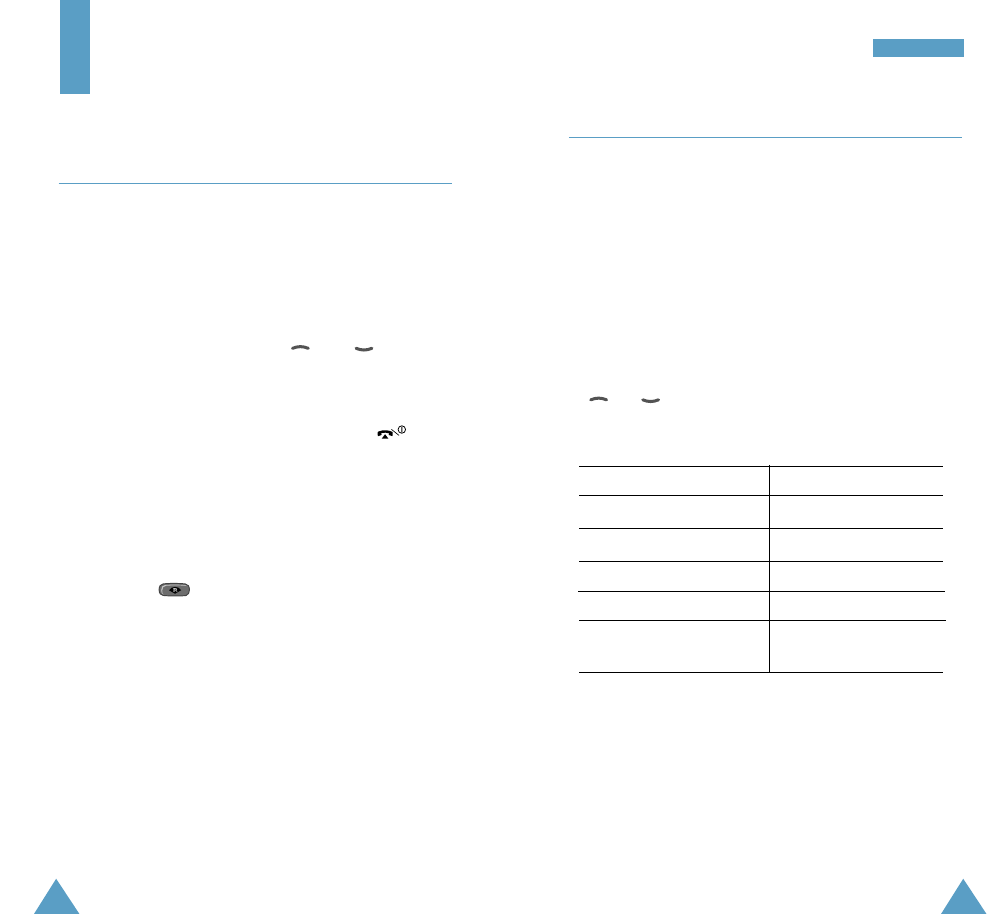
103
RR WWoorrlldd
Multimedia Menu 8-2
In this menu option, you can use the multimedia files
downloaded from R World. You can download up to 3
items.
To play back a multimedia file:
1. When the Show List highlights, press the Select
soft key.
2. When the list of the downloaded items displays,
scroll to the item you want to play by pressing the
or key.
3. Press the Select soft key to start playing the file.
4. To Press the
pause Pause soft key.
resume the playback Play softkey.
adjust the volume volume keys.
repeat the playback Loop soft key.
cancel the repeating End-Loop soft key.
mode
5. To exit the screen, press the CLR key.
102
R World
R-Menu Menu 8-1
This connects you to R World Data Service like video,
audio, games, messaging etc. provided by Reliance.
1. R World logo will be displayed followed by R World
Data Services Menu.
2. Scroll through the menu using and scroll
buttons and launch any Data Services by clicking on
Select key.
3. To exit from Data Services any time, press .
All Data Services may not be available to every
subscriber.
Please contact Reliance for further information.
Note: You can quickly launch R World by pressing and
holding in standby mode.
Entering Text
When prompted, you can enter letters, numbers or
symbols same way as in the phone mode. See page 41
for more information about how to enter characters.

105
RR WWoorrlldd
104
RR WWoorrlldd
• Key Info.: shows you the key helper screen.
• Continue: allows you to continue the last game
you played. This option is activated only when you
already played the game.
4. To stop the game, press the key or the CLR key.
Reset R-Menu Menu 8-4
If the screen is not clear or it often freezes when you
are navigating the R World, you can use this feature to
clear the problem.
When a confirming message displays, select Yes and
then press the OK soft key.
To remove a multimedia file from the phone’s memory:
1. Select the Erase List by pressing the or key.
2. When the list of the downloaded files displays, scroll
to the file you want to delete by pressing the or
key.
To delete all of the files, select All.
3. Press the Select soft key.
4. When a confirming message displays, select Yes and
press the OK soft key.
Games Menu 8-3
This menu option allows you to play the three games;
Push Push, X-Flighter, and Space War.
1. Press the or key to scroll to a game and
press the Select soft key.
The game start screen displays.
2. For Push Push, press the OK soft key and the key
helper screen appears. Press the OK soft key to start
the game.
For X-Flighter or Space War, press the
corresponding number key to select an option:
• New game: starts a new game.
• HighScore: shows you the High Score table.
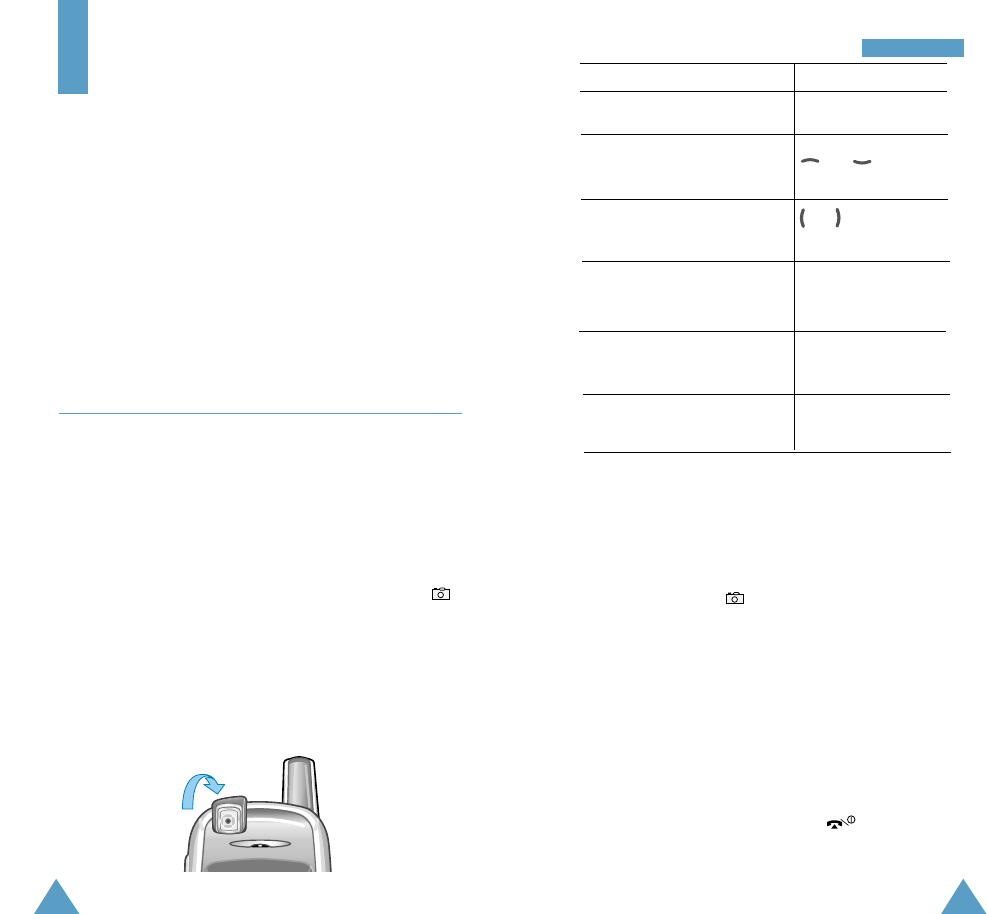
107
CCaammeerraa
106
3. To Press the
flip the image vertically volume keys.
change the image or key.
resolution
zoom in or out the image or key.
(resolution as Low, Med)
use the options Options soft key.
See page 116.
review the picture Review soft key.
stored in your Photo Album
return to the capture CLR key.
mode from the review screen
The numbers on the top right of the display tell you the
total number of the pictures you saved and the
minimum number of the pictures you can take with the
current resolution.
4. Press and hold the key to take the picture.
The phone automatically saves the picture in the
Photo Album (Menu 9-2) and returns to the capture
mode .
5. Press the Review soft key to view the taken picture.
If you want to use the option, press the Options soft
key.
6. When you are finished, press the key to return
to Standby Mode.
Camera
Using the camera module built in your phone, you can
take pictures of people or events while on the move. You
can set a picture as a wall paper image or caller image.
Note:
• Do not take pictures of people without their permission.
• Do not take pictures in a place where the use of a
camera is not allowed.
• Do not take pictures in a place where you may invade
other’s privacy or secret information may be revealed.
Take Photo Menu 9-1
In this menu, you can take a picture. The camera produces
JPEG pictures.
Taking a Picture with the Folder Open
1. Accessing the Take Photo menu turns on the camera
at the top left of the phone. Or, press and hold the
key in Standby Mode.
The image to be captured appears on the display.
2. Adjust the image by rotating the camera module and
aiming it at the subject.

109
CCaammeerraa
108
CCaammeerraa
Color Tones
This options allows you to change the color tone of the
picture. Press the navigation keys to find the tone you
want to use. Mono, Sepia, Negative, Emboss,
Sketch,UV Positive, and UV Negative are available.
To set the phone to adjust the color automatically, select
Auto.
White Balance
This setting adjusts the color balance of the picture to
remove the current lighting conditions add. With this
setting, you can make your picture appear warm or cool.
Scroll to the setting you want to use by pressing the
or key. When you select Manual, you can
adjust the balance using the navigation keys.
Using the Camera options
When you press the Options soft key in the capture
mode, the following options are available for the current
shot:
Flash
You can use the flash which allows you to take a picture
of the best quality when it is dark. Select For This Shot
to use the flash only for the current shot and Always
On to use it for all of the pictures you take. When the
flash turns on, appears on the top right of the
image.
Self Timer
You can set the phone to take a picture at a predefined
time. Once you set the time, appears on the top
right of the image. When you press and hold the start
soft key or key, it counts down and turns yellow
before 3 seconds. The phone automatically takes and
saves a picture when the specified time expires.
Brightness
You can adjust the brightness of the image. When the
brightness is selected Auto, the phone automatically
determines the setting. If Manual is selected, you can
choose the brightness from -5 to +5.
Fun Frames
This option allows you to use a frame on the picture.
Press the navigation keys to find the frame format you
want to use.
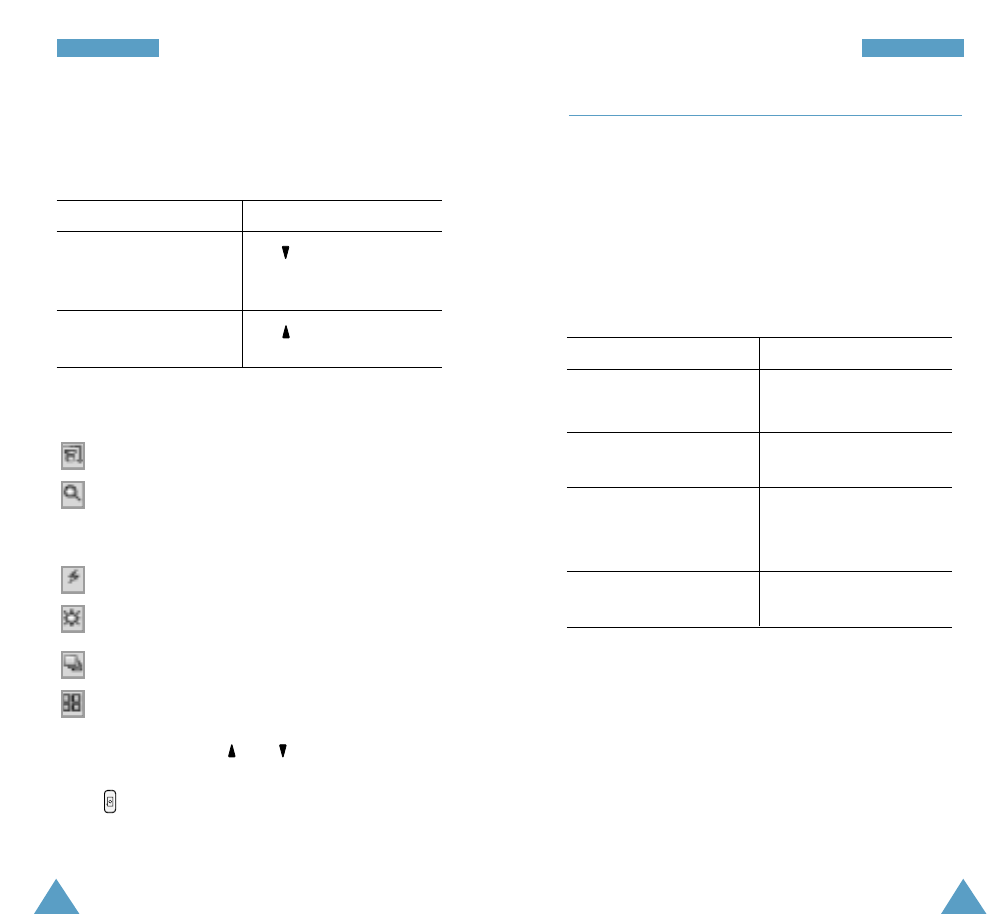
111
CCaammeerraa
110
CCaammeerraa
Photo Album Menu 9-2
In this menu option, you can review the pictures you
have taken. By default, your phone displays them in the
thumbnail mode, which shows pictures as a small
image.
The numbers on the top right of the display tell you the
index number of the current picture and the total
number of the pictures you saved.
To Press the
scroll through the navigation keys.
pictures
use the options Options soft key. For
details, see the next page.
view the selected Expand soft key.
picture in a large size
on the full screen
return to the Thumbnail soft key.
thumbnail mode
Using the Camera options
In the capture mode with the folder reversed, the option
icons appear on the bottom of the display.
To Press
select an option the key. For details
about the option, see
below.
change the setting of the key.
the selected option.
Available options
: (Inversion) flips the picture vertically.
: (Zoom) zooms in the image to enlarge the picture
size by two (X2) or four (X4) times.
(resolution as Low, Med)
: (Flash) turns the flash on or off.
: (Brightness) adjusts the brightness of the image.
: (Resolution) changes the image resolution.
: (Album) allows you to review the pictures stored in
the phone’s memory. You can scroll through the
pictures using the and key.
If you want to go back to capture mode, press the
key.
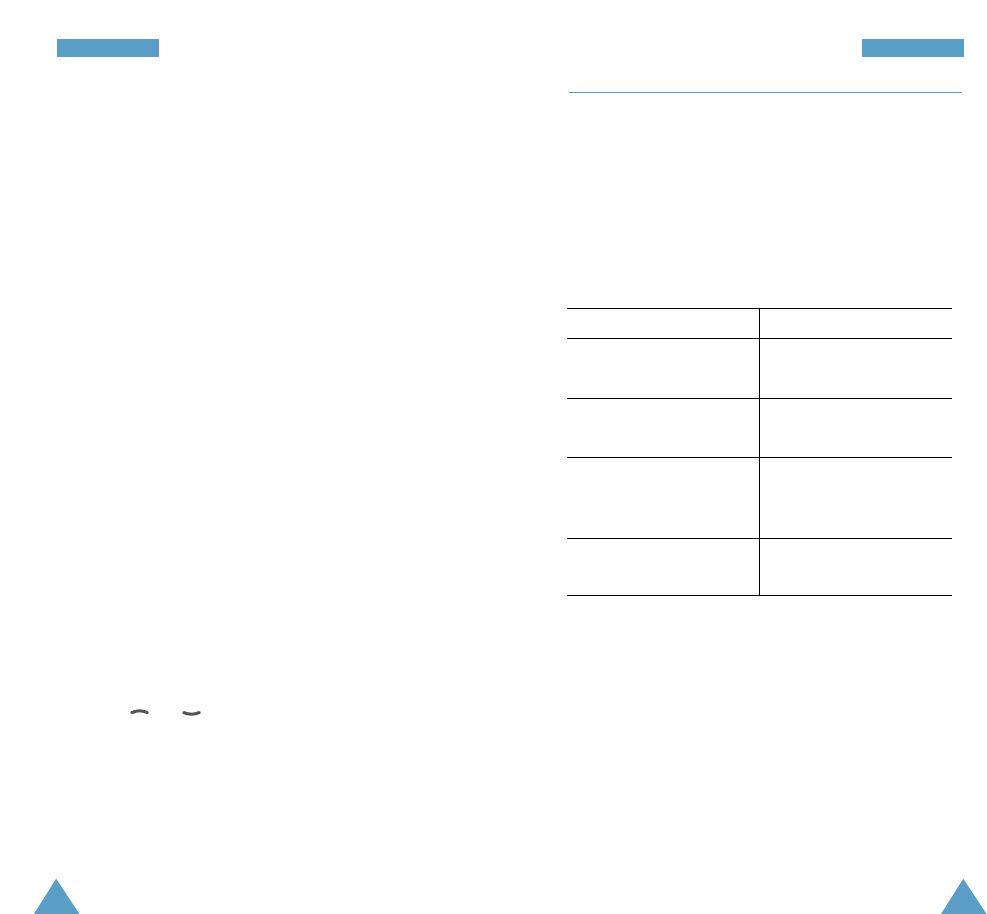
113
CCaammeerraa
112
CCaammeerraa
Photo Wallet Menu 9-3
Photo Wallet allows you to store the pictures
independently, like your photo album. By default, your
phone displays them in the thumbnail mode, which
shows pictures as a small image.
The numbers on the top right of the display tell you the
index number of the current picture and the total
number of the pictures you saved.
To Press the
scroll through the navigation keys.
pictures
use the options Options soft key. For
details, see below.
view the selected Expand soft key.
picture in a large size
on the full screen
return to the Thumbnail soft key.
thumbnail mode
When you press the Options soft key while reviewing a
picture, the following options are available:
Wallpaper: copies the picture into the Photo Wallpaper
image folder. You can use it in the Photo Wallpaper
menu option (Menu 5-4-2).
Phonebook: allows you to set the picture as a caller
image for a Phonebook entry.
Erase: allows you to erase the selected picture or all of
the pictures from Photo Wallet.
Using the Picture Options
Press the Options soft key while reviewing a picture,
and the following options are available:
Camera
You can switch the display to the capture mode.
Save to Wallet
This option copies the picture to the Photo Wallet
menu option (Menu 0-3). See the next page.
Erase
You can erase the selected picture or all of the pictures.
Edit Caption
This option allows you to change the picture’s title
displayed on the right top of the picture in the expand
mode. For further details about how to enter text, see
page 41.
Photo Info.
This option shows you information about the current
picture, such as title, time and date when it was taken,
image size and quality.
The display scrolls the information screen automatically.
Press the or key to scroll the screen by one
item. You can also scroll by one page by pressing the
Scroll soft key.
Expand/Thumbnail
You can switch the display to the thumbnail mode or the
expand mode.

115114
CCaammeerraa
Settings Menu 9-4
This menu allows you to set up the options for using the
camera and pictures.
Lock Photo Review (Menu 9-4-1)
You can lock the pictures so that a person without your
approval cannot review them.
To access the Lock Photo Review menu option, you
need to enter the lock code. It is preset to “0000” at
the factory.
Select On and press the OK soft key. Once you have
locked the pictures, you need to enter the lock code
each time you access the Photo Album and Photo
Wallet menus.
To deactivate this feature, select Off.
Quality (Menu 9-4-2)
You can select the default image quality from Economy,
Normal and Fine.
Health and Safety
Information
Exposure to Radio Frequency (RF) Signals
Your wireless phone is a radio transmitter and receiver.
It is designed and manufactured not to exceed the
emission limits for exposure to radio frequency (RF)
energy set by the Federal Communications Commission
(FCC) of the U.S. Government. These limits are part of
comprehensive guidelines and establish permitted levels
of RF energy for the general population. The guidelines
are based on the safety standards that were developed
by independent scientific organizations through periodic
and through evaluation of scientific studies.
The standards include a substantial safety margin
designed to assure the safety of all persons, regardless
of age and health.
The exposure standard for wireless phones employs a
unit of measurement known as Specific Absorption Rate
(SAR). The SAR limit set by the FCC is 1.6W/kg *.
*In the U.S. and Canada, the SAR limit for mobile phones used by the public is 1.6 watts/kg (W/kg)
averaged over one gram of tissue. The standard incorporates a substantial margin of safety to give
additional protection for the public and to account for any variations in measurements.

117
HHeeaalltthh aanndd SSaaffeettyy IInnffoorrmmaattiioonn
116
HHeeaalltthh aanndd SSaaffeettyy IInnffoorrmmaattiioonn
For Body Operation
To maintain compliance with FCC RF exposure requirements,
use only belt-clips, holsters or similar accessories that
maintain a 1.5 cm. separation distance between the user's
body and the back of the phone, including the antenna.
The use of belt-clips, holsters and similar accessories
should not contain metallic components in its assembly.
The use of accessories that do not satisfy these require-
ments may not comply with FCC RF exposure requirements,
and should be avoided.
For more Information concerning exposure to radio
frequency signals, see the following websites:
Federal Communications Commission (FCC)
http://www.fcc.gov/rfsafety
Cellular Telecommunications Industry Association (CTIA):
http://www.wow-com.com
U.S.Food and Drug Administration (FDA)
http://www.fda.gov/cdrh/consumer
World Health Organization (WHO)
http://www.who.int/peh-emf/en
SAR tests are conducted using standard operating
positions specified by the FCC with the phone
transmitting at its highest certified power level in all
tested frequency bands. Although the SAR is determined
at the highest certified power level, the actual SAR level
of the phone while operating can be well below the
maximum value. This is because the phone is designed
to operate at multiple power levels so as to use only the
power required to reach the network. In general, the
closer you are to a wireless base station antenna, the
lower the power output of the phone.
Before a new model phone is available for sale to the
public, it must be tested and certified to the FCC that it
does not exceed the limit established by the
government-adopted requirement for safe exposure. The
tests are performed in positions and locations (e.g., at
the ear and worn on the body) as required by the FCC for
each model. While there may be differences between
the SAR levels of various phones and at various
positions, they all meet the government requirement.
The FCC has granted an Equipment Authorization for this
model phone with all reported SAR levels evaluated as in
compliance with the FCC RF exposure guidelines. SAR
information on this model phone is on file with the FCC and
can be found under the Display Grant section of
http://www.fcc.gov/oet/fccid after searching on FCC ID
printed in the label on the phone.
FCC certification information for this model phone is
attached separation paper.

119
HHeeaalltthh aanndd SSaaffeettyy IInnffoorrmmaattiioonn
118
HHeeaalltthh aanndd SSaaffeettyy IInnffoorrmmaattiioonn
• Extreme temperatures will affect the charging
capacity of your battery: it may require cooling or
warming first.
• Do not leave the battery in hot or cold places, such as
in a car in summer or winter conditions, as you will
reduce the capacity and life-time of the battery.
Always try to keep the battery at room temperature. A
phone with a hot or cold battery may temporarily not
work, even when the battery is fully charged. Li-ion
batteries are particularly affected by temperatures
below 0 °C (32 °F).
• Do not short-circuit the battery. Accidental short
circuiting can occur when a metallic object (coin, clip
or pen) causes a direct connection between the +
and – terminals of the battery (metal strips on the
battery), for example when you carry a spare battery
in a pocket or bag. Short-circuiting the terminals may
damage the battery or the object causing the short-
circuit.
• Dispose of used batteries in accordance with local
regulations. Always recycle. Do not dispose of
batteries in a fire.
Precautions When Using Batteries
• Never use any charger or battery that is damaged in
any way.
• Use the battery only for its intended purpose.
• If you use the phone near the network’s base station,
it uses less power; talk and standby time are greatly
affected by the signal strength on the cellular
network and the parameters set by the network
operator.
• Battery charging time depends on the remaining
battery charge and the type of battery and charger
used. The battery can be charged and discharged
hundreds of times, but it will gradually wear out.
When the operation time, including talk time and
standby time, is noticeably shorter than normal, it is
time to buy a new battery.
• If left unused, a fully charged battery will discharge
itself over time.
• Use only Samsung-approved batteries and recharge
your battery only with Samsung-approved chargers.
When a charger is not in use, disconnect it from the
power source. Do not leave the battery connected to
a charger for more than a week, since overcharging
may shorten its life.

121
HHeeaalltthh aanndd SSaaffeettyy IInnffoorrmmaattiioonn
120
HHeeaalltthh aanndd SSaaffeettyy IInnffoorrmmaattiioonn
5. Do not take notes or look up phone numbers while
driving. Jotting down a To do list or flipping through
your Phonebook takes your attention away from your
primary responsibility, driving safely.
6. Dial sensibly and assess the traffic; if possible, place
calls when you are not moving or before pulling into
traffic. Try to plan calls when your car will be
stationary. If you need to make a call while moving,
dial only a few numbers, check the road and your
mirrors, then continue.
7. Do not engage in stressful or emotional
conversations that may be distracting. Make the
people with whom you are talking aware that you are
driving and suspend conversations that have the
potential to divert your attention from the road.
8. Use your wireless phone to call for help. Dial the
emergency number in the case of fire, traffic accident
or medical emergencies.
9. Use your wireless phone to help others in
emergencies. If you see a car accident, crime in
progress or other serious emergency where lives are
in danger, call the emergency number, as you would
want others to do for you.
Road Safety
Your wireless phone gives you the powerful ability to
communicate by voice, almost anywhere, anytime. But
an important responsibility accompanies the benefits of
wireless phones, one that every user must uphold.
When driving a car, driving is your first responsibility.
When using your wireless phone behind the wheel of a
car, practice good common sense and remember the
following tips:
1. Get to know your wireless phone and its features,
such as speed dial and redial. If available, these
features help you to place your call without taking
your attention off the road.
2. When available, use a hands-free device. If possible,
add an extra layer of convenience and safety to your
wireless phone with one of the many hands-free
accessories available today.
3. Position your wireless phone within easy reach. Be
able to access your wireless phone without removing
your eyes from the road. If you get an incoming call at
an inconvenient time, let your voice mail answer it for
you.
4. Let the person you are speaking with know you are
driving; if necessary, suspend the call in heavy traffic
or hazardous weather conditions. Rain, sleet, snow,
ice and even heavy traffic can be hazardous.

123
HHeeaalltthh aanndd SSaaffeettyy IInnffoorrmmaattiioonn
122
HHeeaalltthh aanndd SSaaffeettyy IInnffoorrmmaattiioonn
Electronic Devices
Most modern electronic equipment are shielded from
radio frequency (RF) signals. However, certain electronic
equipment may not be shielded against the RF signals
from your wireless phone. Consult the manufacturer to
discuss alternatives.
Pacemakers
Pacemaker manufacturers recommend that a minimum
distance of 15 cm (6 inches) be maintained between a
wireless phone and a pacemaker to avoid potential
interference with the pacemaker. These
recommendations are consistent with the independent
research and recommendations of Wireless Technology
Research.
Persons with pacemakers:
• should always keep the phone more than 15 cm (6
inches) from their pacemaker when the phone is
switched on;
• should not carry the phone in a breast pocket;
• should use the ear opposite the pacemaker to
minimise potential interference.
If you have any reason to suspect that interference is
taking place, switch off your phone immediately.
Hearing Aids
Some digital wireless phones may interfere with some
hearing aids. In the event of such interference, you may
wish to consult your hearing aid manufacturer to
discuss alternatives.
10. Call roadside assistance or a special non-emergency
wireless assistance number when necessary. If you
see a broken-down vehicle posing no serious hazard,
a broken traffic signal, a minor traffic accident
where no one appears injured, or a vehicle you
know to be stolen, call roadside assistance or any
other special non-emergency wireless number.
Operating Environment
Remember to follow any special regulations in force in
any area and always switch off your phone whenever it
is forbidden to use it, or when it may cause interference
or danger.
When connecting the phone or any accessory to another
device, read its user’s guide for detailed safety
instructions. Do not connect incompatible products.
As with other mobile radio transmitting equipment,
users are advised that for the satisfactory operation of
the equipment and for the safety of personnel, it is
recommended that the equipment should only be used
in the normal operating position (held to your ear with
the antenna pointing over your shoulder).

125
HHeeaalltthh aanndd SSaaffeettyy IInnffoorrmmaattiioonn
124
HHeeaalltthh aanndd SSaaffeettyy IInnffoorrmmaattiioonn
Potentially Explosive Atmosphere
Switch off your phone when in any area with a
potentially explosive atmosphere and obey all signs and
instructions. Sparks in such areas could cause an
explosion or fire resulting in bodily injury or even death.
Users are advised to switch off the phone while at a
refuelling point (service station). Users are reminded of
the need to observe restrictions on the use of radio
equipment in fuel depots (fuel storage and distribution
areas), chemical plants or where blasting operations are
in progress.
Areas with a potentially explosive atmosphere are often
but not always clearly marked. They include below deck
on boats, chemical transfer or storage facilities, vehicles
using liquefied petroleum gas (such as propane or
butane), areas where the air contains chemicals or
particles, such as grain, dust or metal powders, and any
other area where you would normally be advised to turn
off your vehicle engine.
Other Medical Devices
If you use any other personal medical devices, consult
the manufacturer of your device to determine if it is
adequately shielded from external RF energy. Your
physician may be able to assist you in obtaining this
information. Switch off your phone in health care
facilities when any regulations posted in these areas
instruct you to do so. Hospitals or health care facilities
may be using equipment that could be sensitive to
external RF energy.
Vehicles
RF signals may affect improperly installed or
inadequately shielded electronic systems in motor
vehicles. Check with the manufacturer or its
representative regarding your vehicle.
You should also consult the manufacturer of any
equipment that has been added to your vehicle.
Posted Facilities
Switch off your phone in any facility where posted
notices require you to do so.

127
HHeeaalltthh aanndd SSaaffeettyy IInnffoorrmmaattiioonn
126
HHeeaalltthh aanndd SSaaffeettyy IInnffoorrmmaattiioonn
Other Important Safety Information
• Only qualified personnel should service the phone or
install the phone in a vehicle. Faulty installation or
service may be dangerous and may invalidate any
warranty applicable to the device.
• Check regularly that all wireless phone equipment in
your vehicle is mounted and operating properly.
• Do not store or carry flammable liquids, gases or
explosive materials in the same compartment as the
phone, its parts or accessories.
• For vehicles equipped with an air bag, remember that
an air bag inflates with great force. Do not place
objects, including both installed or portable wireless
equipment in the area over the air bag or in the air
bag deployment area. If wireless equipment is
improperly installed and the air bag inflates, serious
injury could result.
• Switch off your phone before boarding an aircraft. The
use of wireless phones in aircraft may be dangerous
to the operation of the aircraft, and is illegal.
• Failure to observe these instructions may lead to the
suspension or denial of telephone services to the
offender, or legal action, or both.
Emergency Calls
This phone, like any wireless phone, operates using
radio signals, wireless and landline networks as well as
user-programmed functions, which cannot guarantee
connection in all conditions. Therefore, you should never
rely solely on any wireless phone for essential
communications (medical emergencies, for example).
Remember, to make or receive any calls the phone must
be switched on and in a service area with adequate
signal strength. Emergency calls may not be possible on
all wireless phone networks or when certain network
services and/or phone features are in use. Check with
local service providers.
To make an emergency call:
1. If the phone is not on, switch it on.
2. Key in the emergency number for your present
location. Emergency numbers vary by location.
3. Press the key.
When making an emergency call, remember to give all
the necessary information as accurately as possible.
Remember that your phone may be the only means of
communication at the scene of an accident; do not cut
off the call until given permission to do so.

129
HHeeaalltthh aanndd SSaaffeettyy IInnffoorrmmaattiioonn
128
HHeeaalltthh aanndd SSaaffeettyy IInnffoorrmmaattiioonn
• Do not use harsh chemicals, cleaning solvents or
strong detergents to clean the phone. Wipe it with a
soft cloth slightly dampened in a mild soap-and-
water solution.
• Do not paint the phone. Paint can clog the device’s
moving parts and prevent proper operation.
• Do not put the phone in or on heating devices, such
as a microwave oven, a stove or a radiator. The
phone may explode when overheated.
• Use only the supplied or an approved replacement
antenna. Unauthorized antennas or modified
accessories may damage the phone and violate
regulations governing radio devices.
• If the phone, battery, charger or any accessory is not
working properly, take it to your nearest qualified
service facility. The personnel there will assist you,
and if necessary, arrange for service.
Care and Maintenance
Your phone is a product of superior design and
craftsmanship and should be treated with care. The
suggestions below will help you fulfill any warranty
obligations and allow you to enjoy this product for many
years.
• Keep the phone and all its parts and accessories out
of the reach of small children.
• Keep the phone dry. Precipitation, humidity and
liquids contain minerals that will corrode electronic
circuits.
• Do not touch the phone with a wet hand. Doing so
may cause an electric shock to you or damage to the
phone.
• Do not use or store the phone in dusty, dirty areas, as
its moving parts may be damaged.
• Do not store the phone in hot areas. High
temperatures can shorten the life of electronic
devices, damage batteries, and warp or melt certain
plastics.
• Do not store the phone in cold areas. When the
phone warms up to its normal operating temperature,
moisture can form inside the phone, which may
damage the phone’s electronic circuit boards.
• Do not drop, knock or shake the phone. Rough
handling can break internal circuit boards.

131
HHeeaalltthh aanndd SSaaffeettyy IInnffoorrmmaattiioonn
130
HHeeaalltthh aanndd SSaaffeettyy IInnffoorrmmaattiioonn
• Reorient or relocate the receiving antenna.
• Increase the separation between the equipment
and receiver.
• Connect the equipment into an outlet on a circuit
different from that to which the receiver is
connected.
• Consult the dealer or an experienced radio/ TV
technician for help.
Acknowledging Special Precautions and the FCC
and Industry Canada Notice
Cautions
Modifications not expressly approved by the party
responsible for compliance could void the user's
authority to operate the equipment. FCC Compliance
Information
This device complies with Part 15 of FCC Rules.
Operation is subject to the following two conditions:
(1) This device may not cause harmful interference, and
(2) This device must accept any interference received.
Including interference that may cause undesired
operation.
Information to User
This equipment has been tested and found to comply
with the limits for a Class B digital device, pursuant to
part 15 of the FCC Rules. These limits are designed to
provide reasonable protection against harmful
interference in a residential installation.
This equipment generates, uses and can radiate radio
frequency energy and, if not installed and used in
accordance with the instructions, may cause harmful
interference to radio communications. However, there is
no guarantee that interference will not occur in a
particular installation. If this equipment does cause
harmful interference to radio or television reception,
which can be determined by turning the equipment off
and on, the user is encouraged to try to correct the
interference by one or more of the following measures:

133
GGlloossssaarryy
132
DTMF - (Dual-tone Multi-Frequency ) You send DTMF
signals when you enter numbers by pressing the digit
keys.
EVRC - (Enhanced Variable Rate Codec) EVRC is a new
global standard for compressing and decompressing
voice signals. EVRC uses a lower bit rate (the number of
bits sent per second) than existing CDMA vocoders,
while providing significant improvements in voice
quality. This technology enables your phone to provide
superb voice quality while benefiting from the ability to
process more cellular voice calls using less bandwidth
than the voice codecs in CDMA networks today.
Frequency - A measure based on time, as one or more
waves per second, in an electrical or light wave
information signal. A signal’s frequency is stated in
cycles-per-second or Hertz (Hz).
Hands-Free - A feature that permits a driver to use a
wireless phone without lifting or holding the handset -
an important safety feature for automobiles, tractors
and most other motorized vehicles.
LCD - (Liquid Crystal Display) Commonly used to refer
to the screen display on the wireless phone.
LED - (Light Emitting Diode) Commonly used to refer to
a small light on the wireless phone or on the Desktop
Charger. The LED lights on the phone to indicate an
incoming call. The lights on the charger indicate that
battery charging is taking place.
Glossary
Airtime - Actual time spent talking on the wireless
phone. Most carriers bill customers based on how many
minutes of airtime they use each month.
Antenna - A device for transmitting or receiving signals.
The size and shape of antennas is determined, in part,
by the frequency of the signal they receive. Wireless
phones and the base station must have antennas.
Base Station - The fixed radio transmitter/receiver that
maintains communications with mobile radio telephones
within a given area. (Typically called a cell or cell site)
CDMA - (Code Division Multiple Access) A spread-
spectrum approach to digital transmission. With CDMA,
each conversion is digitized and then tagged with a
code. The mobile phone deciphers only a particular code
to pick the right conversation off the air. The transmitted
signal is just above noise level across the available
bandwidth.
Channel - Communications signals transmit along paths
called channels.
Codec - Compression & Decompression.
Deactivation - The process of rendering a wireless
phone inactive.

135134
GGlloossssaarryyIndex
A
Accessories • 9
Air time • 140
Alarm (7-4) • 98
Alerts (4-3) • 77
B
Backlight (5-6) • 82
Banner (5-5) • 81
Battery
charging • 18
installing • 17
low battery indicator • 20
removing • 18
precautions • 126
C
Calculator (7-5) • 99
Callanswering • 34
emergency • 26
ending • 26
forwarding • 39
from Phone Book • 27
making • 25
missed • 37
redialing last • 27
three way • 40
waiting • 39
Caller ID • 37
Camera • 114
Care • 136
Characters, entering • 41
Charging batteries • 18
Connect tone (4-3) • 77
Correcting number • 26
D
Dialling
pause • 31
prepend • 28
speed • 28
voice • 33, 84
Disconnect tone (4-3) • 77
Display
LCD • 13
DTMF tone
length (4-4) • 78
Dual clock (5-7) • 83
E
Erase History (3-4) • 73
Erase Messages (2-6) • 67
F
Finding
phonebook (1-1)• 53
G
Games (9-3) • 112
I
Icon description • 13
Inbox (2-2) • 64
In-call options • 35
Incoming calls (3-2) • 72
Installing battery • 17
Prepend - The addition of a prefix, such as an area
code, to a phone number.
RF - Radio Frequency
Roaming - The ability to use a wireless phone to make
and receive calls in places outside of the home service
area.
Service Charge - The amount paid each month to
receive wireless service.
Standby Time - The amount of time a fully charged
wireless portable or transportable phone can be on and
idle without being in use. (See Talk Time)
Talk Time - The length of time a person can talk on a
portable or transportable wireless phone without
recharging the battery.
Vocoder - Voice Coder. A device used to convert speech
into digital signals.
Wireless - Radio-based Systems that allow
transmission of telephone or data signals through the air
without a physical connection, such as a metal wire
(copper) or fiber optic cable.

137
IInnddeexx
136
IInnddeexx
S
Safety
batteries • 126
information • 135
precautions • 7
Schedular (7-1) • 92
Searching
phonebook (1) • 53
Security (8-3) • 106
Service alert (4-3) • 77
Service light • 16
Set NAM (8-2) • 105
Set time (8-2) • 105
Sound (4) • 75
Speed dialling • 28
Standby mode • 23
Switching on/off phone • 21
T
Task List (7-2) • 95
Text, entering • 41
Today (7-1) • 92
Tone length (4-4) • 78
T9 text mode • 43
U
Unpacking • 9
V
Version (8-2) • 105
Voice dial (6-1) • 84
Voice mail (2-8) • 70
Voice memo (6-2) • 87
Volume adjusting
ring (4-2) • 76
key (4-4) • 78
W
World time (7-6) • 100
Writing new message (2-1) • 61
K
Key Beep (4-4) • 78
Keys
description • 11
location • 10
L
Language (5-1) • 79
Last number redialing • 27
Letters, entering • 41
Listening
voicemail (2-8) •70
voice message (6-3) • 89
Lock code • 107
Low battery indicator • 20
M
Maintenance • 136
Memo pad (7-3) • 97
Memory (1-4) • 60
Menus
list • 50
scrolling • 48
shortcuts • 49
Messages
erasing (2-6) • 67
setup (2-7) • 68
voice (2-8) • 70
Missed calls • 37
Modes
phone • 23
text input • 41
N
Names
entering • 41
find (1-1) • 53
NAM setting (8-2) • 105
Number
adding in an entry (1-2) • 55
correcting • 26
searching (1-1) • 53
O
Outbox (2-3) • 65
P
Phone
layout • 10
lock (8-3) • 106
Phonebook (1) • 53
Power save mode • 24
Prepend dialling • 28
R
Redialing
auto (8-1) • 103
last call • 27
Removing battery • 18
Reset phone (8-3) • 109
Ring
type (4-1)• 75
volume (4-2) • 76
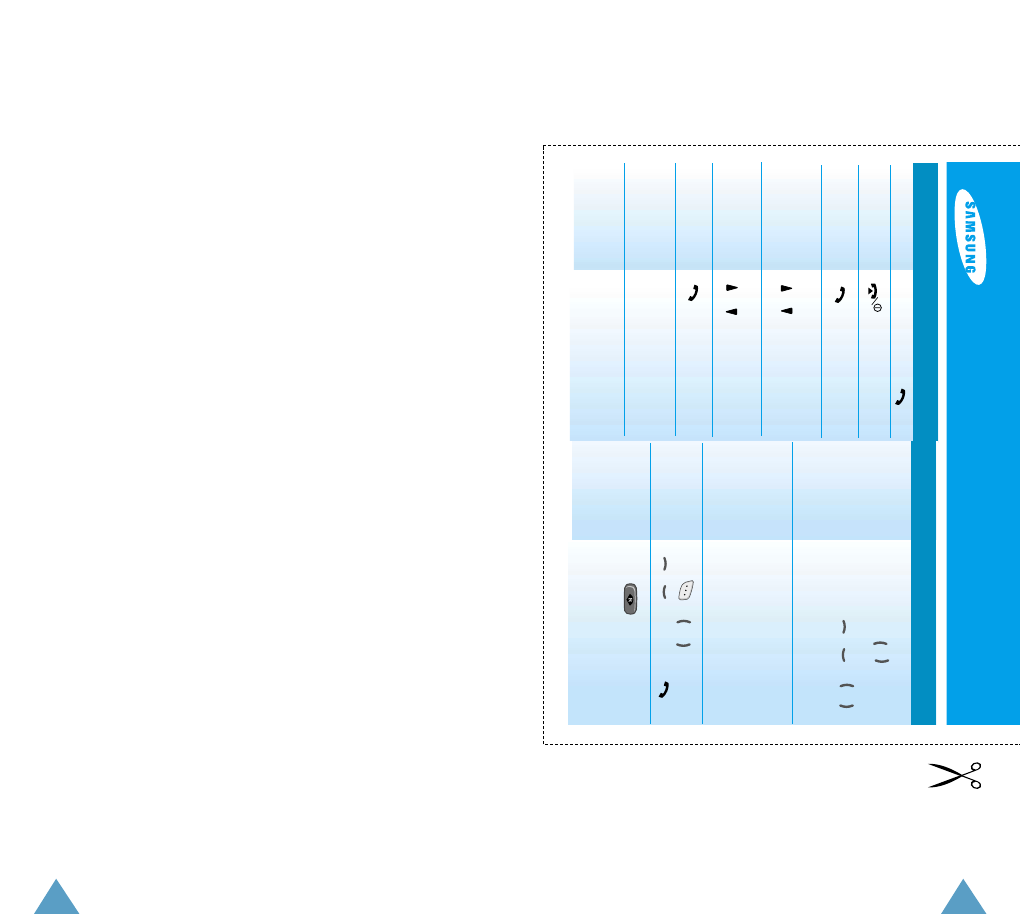
139138
Save a Number Number + Save + Select +
Name + Next + /
(Category) + Select +
If necessary, / + /
to change the settings or Edit
to enter information + Save
Speed dialing Enter memory location of
desired number, holding the
last digit to automatically
dial.
Phonebook Press + /
Search + / + Select or
Launch R World Press .
SCH-N393 Quick Reference Card
BASIC OPERATIONS
Make a call Phone number +
End a call
Receive a call or open the phone
Adjust the key (in Standby Mode)
beep volume / on the left side
Adjust the (during a conversation)
speaker volume / on the left side
Redial the last call twice
Switch to the Hold #
vibrate mode
Voice dialing Hold *or open the folder
+ Say a name

141140
Licensed by QUALCOMM Incorporated under one or more
of the following Patents.
U.S Patent No. 4,901,307 5,056,109 5,099,204
5,101,501 5,103,459 5,107,225
5,109,390
Main Menu (To access, press the Menu soft key)
1 : Phone Book 1 : Find
2 : Add Entry
3 : Groups
4 : Memory Status
2 : Messages 1 : Write
2 : Inbox
3 : Outbox
4 : Saved
5 : Templates
6 : Erase Messages
7 : Settings
8 : Voice Mail
3 : Call History 1 : Missed
2 : Received
3 : Dialled
4 : Erase History
5 : Call Duration
4 : Sound 1 : Ring T ones
2 : Ringer Volume
3 : Alerts
4 : Key T o n e
5 : Power On/Off Melody
5 : Display 1 : Language
2 : Service Ar e a
3 : Menu Theme
4 : Wallpaper
5 : Banner
6 : Backlight
7 : Set Dual Clock
8 : Service LED
6 : Voice Tools 1 : Voice Dial
2 : Voice Memo
3 : Answering Machine
7 : Or ganiser 1 : Scheduler
2 : T ask List
3 : Memo Pad
4 : Alar m
5 : Calculator
6 : W orld T i m e
7 : Countdown
8 : Settings 1 : Call
2 : Phone/System
3 : Security
9 : R W orld 1 : R-Menu
2 : Multimedia
3 : Games
4 : Reset R-Menu
0 : Camera 1 : Take Photo
2 : Photo Album
3 : Photo Wallet
4 : Settings
LIST OF MENU FUNCTIONS